
















Together with you, Goldschmidt develops smart and reliable solutions – for safe, sustainable and long-lasting railways of premium quality.
Goldschmidt offers you a comprehensive range of high-quality and reliable products and services worldwide for the construction, maintenance and monitoring of your railway infrastructure. With our products and services, combined with our smart digital solutions, we are pushing for the digital future of track. We are always at your side – wherever you are. With our global presence, your Goldschmidt products and services are available locally, as is the support of your local contact.

Dear Readers,
This issue coincides with Train & Rail, taking place in Stockholm, Sweden, in May. The event brings together stakeholders from across the rail industry and serves as a key platform for knowledge sharing, innovation and networking. You can read more about what to expect from this year’s edition and how it aims to shape the future of rail in our event feature (p.12).
Joey Stoate delves into the topic of Reverse Beeching (p.6), exploring the efforts being made to reopen former railway lines that were closed in the 1960s. With a growing focus on sustainable transport and connecting communities, this initiative has proved popular – but it’s not without its challenges.
Also in this issue, we’re featuring some fascinating contributions
by our suppliers. Rail BI examines how Network Rail is using asset work bank planning to improve the efficiency and coordination of signalling projects (p.38). As digitalisation continues to expand across the sector, Nomad Digital takes a look at The Cybersecurity Landscape for Rail (p.32), highlighting the importance of robust strategies to protect critical infrastructure. And in a case study that blends transport and cultural preservation, Pandrol discusses how the Florence Tramway was engineered to minimise vibrations and safeguard the city’s UNESCOlisted heritage site (p.84).
We hope you enjoy reading this issue and find the insights valuable. If you’d like to receive our rail news directly in your inbox, you can subscribe here. To be featured on our site or in an upcoming e-magazine, please contact Andrew Lush at al@a2bglobalmedia.com or +44 7432 725001.
As always, we welcome your thoughts and feedback – get in touch with us by sending an email to editorial@a2bglobalmedia.com.

Josephine Cordero Sapién, editor-in-chief
ANDREW LUSH Director al@a2bglobalmedia.com
JOSEPHINE CORDERO SAPIÉN Editor-in-chief jcs@a2bglobalmedia.com
NICOLA BROWN Head of Sales nb@a2bglobalmedia.com
ZOE GRIFFEY Head of Design zg@a2bglobalmedia.com
TIANA MAY Principal Journalist tm@a2bglobalmedia.com
JOEY STOATE Journalist js@a2bglobalmedia.com a2b Global Media Ltd The Generator Hub, The Gallery Kings Wharf
The Quay, Exeter EX2 4AN
Office: +44 (0)1392 580002 Mobile: +44 (0)7432 725001
Email: info@railway-news.com Website: railway-news.com
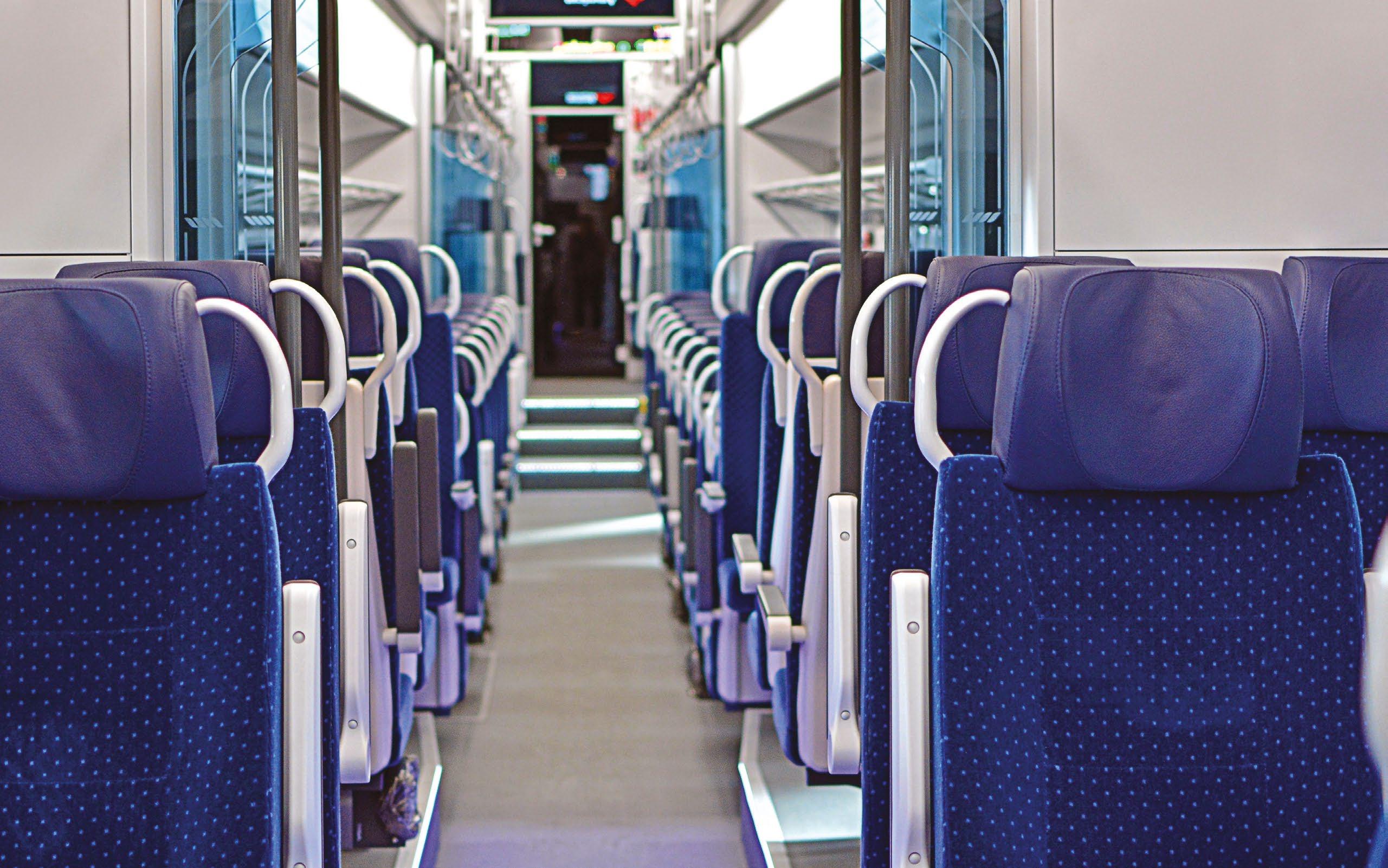



p.6
Featuring Reverse Beeching: A Potential Lifeline for a Historic Solution
Joey Stoate looks at the history of railway line closures in the UK following the Reshaping of British Railways report and at what has happened to some of those railway lines since.
p.10
Directory
A directory of railway suppliers for data & monitoring, track & infrastructure, rolling stock and services. Read about all the latest innovations and product developments in the rail sector.
Data & Monitoring – p.15
Track & Infrastructure – p.45
Rolling Stock– p.87
Services – p.111
p.12
Train & Rail 2025
Taking place at Stockholmsmässan in Sweden, this year’s Train & Rail is the second iteration of the event.
p.14
A look at what key railway events are taking place between January and March 2025.

By Joey Stoate

In 1963, noted physicist Dr Richard Beeching, who was appointed chair of the British Railways Board under the Macmillan government, published the first of two reports that would alter the state of rail services in the United Kingdom for the generations to come.
The Reshaping of British Railways, a report detailing a series of proposals for the future of rail within the United Kingdom, called for the closure of around 2,400 of the country’s railway stations, removing rail access for roughly 5,000 route miles and, according to Beeching, saving up to 18 million GBP per year.
The proposals, which also included the cutting of nearly 67,700 railway jobs over the course of a threeyear period, were, naturally, met with a large amount
of criticism from many corners, with particular ire drawn from unions, the Labour party (who would, ultimately, choose to continue to implement a number of Beeching’s proposals) and, of course, average railway users across the country.
Beeching’s first report came following the country’s Railway Mania phase of the 19th century, a period of massive investments into the UK rail network that came to a halt in the 1860s. The large financial investment that had been poured into the system became unsustainable and as a result, the country quickly started falling behind, unable to keep up with increasing demand for rolling stock and general repair costs, problems that were compounded by the existence of duplicated routes. In the 1950s,
the adoption of personal vehicles competed with railway demand and investment, which led to a rapid deterioration of the railways in many crucial areas.
Upon investigation, Beeching found that the UK’s railways operated at a substantial loss through a lack of use, an abundance of unnecessary services and exorbitant operating costs, and his proposals were levelled in such a way as to ignore emotion altogether, stating in an address to the Institute of Directors in 1962 that “an emotional approach to the railways was not helpful, and that there was far too much opinion and not enough understanding of the problem.”
Following Dr Beeching’s proposals, railway stations across the country began to close, restructure or cease operations almost entirely, though it is important to note that the trend of decommissioning railway lines started in the 1920s by the railway companies themselves, and when the railways were nationalised after WWII, a further 3,000 miles of track were closed.
Routes affected by the Beeching proposals included both Nottingham & Sheffield Services to London Marylebone, Edinburgh to Carlisle, Perth to Kinnaber and many more across the thousands of services affected by what is colloquially referred to as the ‘Beeching Axe’, with station and line closures sweeping the nation as a whole.
In 1965, Beeching published his second report, The Development of the Major Railway Trunk Routes, which put forth a set of proposals suggesting that of the the 7,500 miles of trunk rail routing in the United Kingdom, a total of only 3,000 miles should be chosen for future investments, routing all remaining rail traffic through nine dedicated lines across the country.
As a result, Beeching proposed that traffic to the north-east side of the UK would operate through the East Coast Main Line north of Newcastle, traffic to Wales & the West Country would operate along the Great Western Main Line before reaching Swansea & Plymouth and traffic to Birmingham, Manchester, Liverpool, Coventry and Scotland would therefore operate along the West Coast Main Line running to both Carlisle and Glasgow.
These proposals, which were roundly rejected by the Labour government, were influenced by Beeching’s belief that large amounts of the rail network were still operating an excessive number of duplicate services, and whilst the report did not put forth any additional closures, the direction of investment would nevertheless funnel resources to these nine main lines.
Following the rejection of his latest set of proposals,

Beeching returned to his post at British chemical company, ICI. Whilst there has never been any official statement as to the reasoning behind the early termination of his governmental advisory position, it is widely believed that he may have been fired following the failure of his second attempt at the reinvention of the rail network.
With the UK’s rail network having lost a monumental number of services, large numbers of potential commuters were left without options for travel in rural communities throughout the UK, with regions such as the South West left with the bare minimum number of potential connections to reach further destinations. Those without cars were recommended to catch replacement bus services that would transport them to the nearest railway station in order to complete journeys, but with slower service and less convenience, the bus replacement scheme was scrapped within two years of their introduction.
Later governments certainly made their own attempts at cuts of their own, with both the 1970 Conservative Government and Thatcher’s Government in 1982 compiling their own reports into the feasibility of further condensing the railways, but nothing was ever truly committed, leaving the railway pruned to a slim figure for the foreseeable future.
Reverse-Beeching: The Return of the Rural Railway In November 2017, the Conservative government announced that it was formulating plans to reverse a number of closures made as a result of the Beeching Report of the 1960s, reintroducing services at stations that, at the time, were either serving as hubs for heritage rail journeys or lay dormant altogether. The decision was made to address congestion and introduce transport options for burgeoning rural communities left without adequate transport infrastructure.
Beeching found that the UK’s railways operated at a substantial loss through a lack of use, an abundance of unnecessary services and exorbitant operating costs, and his proposals were levelled in such a way as to ignore emotion altogether

Whilst a number of lines and associated stations shelved by the Beeching cuts had been re-opened in the past, the new initiative opted to reinstate a number of lines as an alternative to building new infrastructure. In 2020, the government announced the ‘Restoring Your Railway’ fund, a 500 million GBP pot intended to be invested in developing proposals, feasibility studies and business cases for the re-opening of local lines and stations across the country, the repurposing of existing freight lines for passenger services and modification of former routes lost to urban expansion.
Over the next four years, 38 separate projects managed successful bids for further feasibility investigation, with bids approved for schemes all over the UK, with one of the most notable ones being the reinstatement of a full passenger service on Devon’s Dartmoor Line between Okehampton and Crediton.
The Dartmoor Line was officially withdrawn by British Rail in 1972, before seeing a limited service as a heritage railway line between 1997 and 2019. During this period, weekly journeys were operated by the Dartmoor Railway, a local company running weekend services during the summer months.

In February 2020, the railway entered administration following the end of heritage services, with all remaining rolling stock relocated to Meldon Quarry after its closure in 2011.
In 2021, ownership of the line was transferred to Network Rail, following the announcement of its reopening as part of the Restoring Your Railway scheme in 2020, with lines set to commence re-operation in November that very same year
The line, which was delivered 10 million GBP under budget, had served more than 550,000 passengers by its second anniversary in 2023, having successfully extended bus services towards towns such as Tavistock, Launceston and Bude since its re-opening.
The opening of the line has since been considered one of the greatest successes of the programme as a whole, with more than 250,000 passengers travelling on the line within the first 12 months of its re-opening, prompting the construction of a brand new station, Okehampton Interchange, on the eastern side of the town.
In 2024, the Labour Chancellor of the Exchequer, Rachel Reeves, announced the end of the ‘Restoring Your
Railway’ fund, stating that any un-completed projects would, ultimately, be cancelled in order to reduce national spending.
However, for those in rural communities, not all is lost. For towns such as Portishead, there is still light at the end of the (probably phone-signal devoid) tunnel.
Residents of the town recently received the news that the The West of England Combined Authority has pledged an investment of 27 million GBP to restore the former Portishead Railway line, with work on the connection to Bristol set to begin this summer and completion expected around 2027.
In other regions, work is now well underway to restore the Camp Hill Line in Birmingham, and Charleston Station, South Gloucestershire, is set to re-open in 2027 following a feasibility study authorised in 2019.
Dr. Beeching’s efforts to reduce strain on the railway network may have been something of a ‘tough-love’ approach to the redesign of the United Kingdom’s system, but it’s clear that whilst some decisions might have been made for the greater good, the voices of rural communities can bring back even the most forgotten tracks.
Click here to read more from Joey Stoate.




When: 6–8 May 2025
Organiser: Swedtrain and Stockholmsmässan
Train & Rail has established itself as the Nordic region's largest trade fair for sustainable rail transport. The biennial event first took place in April 2023 and is set to return for its second edition in May 2025.
The 2023 edition attracted 151 exhibitors and 3,037 visitors. This year’s event aims to build on this initial success, serving as a pivotal meeting point for industry professionals, policymakers and innovators.
The Train & Rail exhibition will feature leading companies including Alstom, CAF, Hitachi Rail and Siemens Mobility to present the latest products and solutions. Attendees will have the opportunity to experience live demonstrations of new technologies and gain insight into the future of rail transport.
A range of products and services will be on show, including rail vehicles for freight and passenger traffic; solutions for public, regional, long-distance and international rail traffic; signalling and traffic

management systems; and ticketing systems. The exhibition floor will also serve as a hub for professionals to connect and build collaborations and partnerships within the industry.
Unlike the first edition, which featured a paid conference, this year’s event will offer two open stages in the exhibition hall, allowing all visitors free access to the seminar programme.
The programme will cover key topics including sustainable railway development, digitalisation, safety, ERTMS and workforce development. The Swedish Transport Administration will also contribute sessions on railway research and innovation.
Monika Johannesen Widholm, Project Manager for Train & Rail said: “We in the programme group are very satisfied with the seminar programme,where the entire industry is represented.The two large stages provide the breadth needed to discuss the many issues facing the railway industry,with a focus on how we will solve the challenges.”

This year’s edition of Train & Rail aims to address three key themes across both the exhibition and conference programme:
The event will explore emerging technologies like digitalisation, automation and energy-efficient solutions, examining how they can enhance the capacity, reliability and sustainability of rail transport. This will include a focus on smart transportation systems, innovative design and technologies such as ERTMS and CBTC.
Discussions surrounding this theme will centre on how technology and innovation can help create robust, sustainable systems that meet future travel demands.
This theme will emphasise the need to attract, train and retain skilled workers in the sector. It will focus on addressing challenges like generational change, new technologies, increasing demand and competition from other industries.
The discussions will explore the necessary partnerships between educational institutions and the industry, as well as strategies for developing work environments and implementing lifelong learning to ensure the future of rail transport.
Finally, Train & Rail will focus on the current maintenance backlog and the need for a long-term strategy to ensure the rail transport system functions as planned. It will highlight innovative solutions for more efficient maintenance practices, improved planning and prioritisation, digitalisation and optimised resource use.
Relevant discussions throughout the event will explore what is needed from maintenance planning to address both current and future requirements.
The Railway-News team will be attending Train & Rail and we hope to see you there! Stay tuned or subscribe to our newsletter to keep up to date with the latest news from the event.
To find out more visit trainrail.se

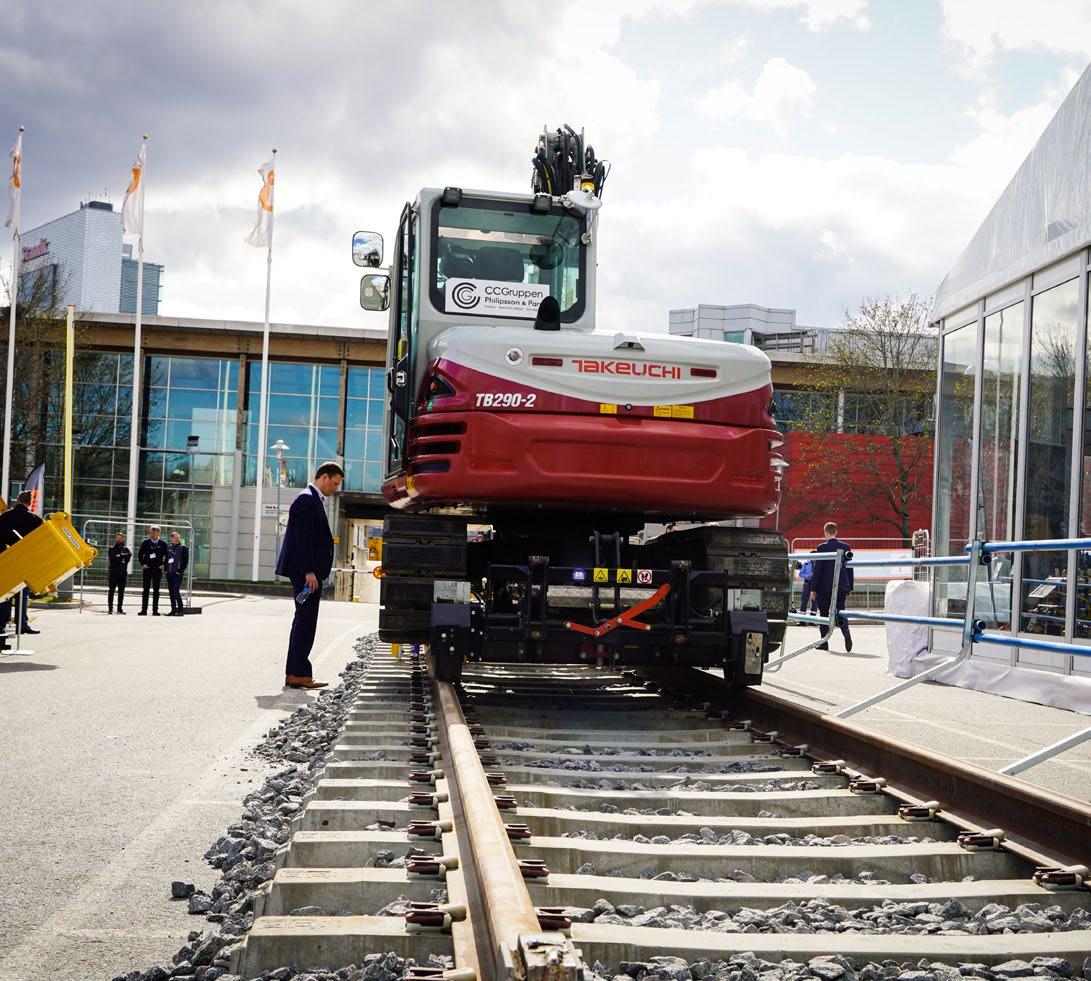


Connectivity & Wi-Fi
Icomera p.16
Computers, Sensors, Big Data
NEXCOM International Co., Ltd. p.19
SENSIT s.r.o. p.22
Condition Monitoring p.-
Viper Innovations p.23 Trimble p.26 SKF p.29
Cybersecurity
Nomad Digital p.32
Measurement & Testing Services ASC Sensors GmbH p.35
Planning & Management Software

Communications Technology
p.41

By Patrik Persson, Business Development Director – Cellular and Satellite Data, Icomera
Intoday’s digital world, passengers expect to stay connected wherever they go, and train travel is no exception.
Whether streaming entertainment, working remotely or staying in touch with friends and family, uninterrupted high-speed connectivity is now a fundamental passenger requirement. At the same time, operators rely on robust connectivity for realtime monitoring, diagnostics and enhanced onboard services.
The quality of on-train internet connectivity is highly dependent on the coverage and capacity of communication networks along the route. Today, this connectivity is largely delivered through cellular networks.
Despite rapid advancements in 4G and 5G deployment in urban areas, building robust network infrastructure along long, remote railway corridors has historically been both technically challenging and financially unfeasible. As a result, large portions of rail networks still experience gaps where cellular networks fail to meet passenger demand.
Encouragingly, recent advancements in satellite technology and commercial models have made low Earth orbit (LEO) satellite solutions a game-changer. LEO satellites now provide a viable, cost-effective means of delivering uninterrupted, high-performance connectivity to trains, serving as a powerful addition to any transport operator’s connectivity strategy.
More than two decades ago, Icomera pioneered train connectivity using geostationary (GEO) satellite technology. However, the rapid development of cellular networks meant that GEO satellites were soon outperformed in terms of cost and efficiency. Today, LEO satellite technology has reshaped the landscape, offering significant advantages over its predecessors:
• Reduced Latency: LEO satellites orbit at altitudes up to 2,000km, much closer to the Earth’s surface than GEO satellites, meaning signals travel a shorter distance, resulting in lower latency.
• Higher Data Throughput: LEO satellites provide superior data throughput, enabling faster and more efficient data transfer.
• Cost-Effective Deployment: The lower altitude and smaller orbital radius of LEO satellites reduces the energy requirements for launch, making global coverage more accessible for satellite constellations.

• Increased Reliability: LEO satellites can be interconnected in a mesh network configuration, allowing cross-linking between satellites. If one satellite experiences an issue or goes offline, the other satellites within the network can compensate for the loss, ensuring uninterrupted service.
Starlink is the current market leader in LEO, with more satellites in orbit than any other provider. Starlink Electronic Phased Array Tiles for Rail are fully certified

for operation in public transport environments, offering high-throughput, low-latency connectivity for any vehicles travelling up to speeds of 400mph (643km/h).
Even prior to becoming an authorised reseller of SpaceX’s Starlink solution designed specifically for trains, Icomera has been actively involved in multiple successful LEO satellite internet deployments on both sides of the Atlantic. Some have included trains in revenue service, while others have been technical trials aimed at pushing the technology to achieve its full potential.
The results have been impressive, delivering the equivalent of inner-city 5G capacity to trains in rural environments with throughput consistently in the range of 200+ Mbps when aggregating Starlink terminals, and some deployments demonstrating a latency of less than 40 milliseconds.
Additionally, across our current satellite connectivity solution deployments we have observed that by simultaneously aggregating Starlink and terrestrial cellular connectivity, one network can fill in for the other whenever its connection drops, offering consistent availability across the route. The combination of both networks typically provides a stable internet connection capable of supporting dataheavy applications such as video streaming for over 99% of the route.
As a global leader in connected transport solutions, Icomera is at the forefront of integrating LEO satellite technology with terrestrial cellular networks to deliver a hybrid approach to connectivity. Leveraging ingenious technology, Icomera’s advanced aggregation platform seamlessly blends multiple networks – including LEO satellite and 5G – to maximise performance, reliability and coverage.
In addition to giving passengers the home broadband experience on the move, operators will increasingly look to utilise this high-speed, low-latency connectivity, for real-time monitoring, remote diagnostics and onboard systems management – intelligent solutions that do more than just connect – they enhance, they protect and they optimise.
Whether traversing bustling cities or remote landscapes, we aim to be inspiring partners in driving the rail industry’s digital transition, paving the way for a future where passengers and operators enjoy seamless connectivity.
For more information on a smart, connected journey, view our solutions. Alternatively, if you have any questions, email us
Your Partner for the Smart, Connected Journey
For over two decades, Icomera has kept you connected on the move, delivering seamless onboard connectivity
Our networks have the power to fully integrate tens of thousands of vehicles into the cloud, paving the way for a bold new generation of safer, more efficient and sustainable transport solutions.


Rail vehicles require robust video surveillance systems, but harsh environments and power instability present significant challenges. Voltage fluctuations and outages can damage onboard computers and compromise critical data, impacting safety.
NEXCOM's nROK 7280-AC5IP addresses these challenges with a powerful edge computing platform. It features five PoE++ ports for seamless integration with PoE cameras and includes dedicated storage for operating systems and video management software (VMS).
Furthermore, the VTK-SCAP battery backup unit (BBU), utilizing supercapacitor technology, ensures reliable power, continuous operation, and data integrity. This enhances the safety and efficiency of rail transportation.
AI Railway Telematics Computer
nROK 7280-AC5IP
• Powered by Intel® Core™ Ultra, Meteor Lake-H
• Up to 26TOPS AI computing power
• 1 x 2.5GbE PoE++ and 4 x 2.5GbE PoE+ X-coded ports

• Power input: 24VDC or 24–110VDC, with isolation IP67 rated, operating temperature range: -40°C to 60°C
Backup Battery Unit
for Railway Application
VTK- SCAP-AR-M (Master)
VTK- SCAP-S (Slave)
• High power density EDLC (Electric Double Layer Capacitor) technology
• Over 500,000 cycle life (charging/discharging)


• Operating Temperature: -35~80°C Expandable to 1 master and 3 slaves, with a maximum output of 200W


With the rapid advancement of technology, AI has become an integral part of daily life, revolutionising industries with innovative solutions. The transportation sector, particularly trains, subways and other rail systems, increasingly relies on image analysis to meet essential safety and operational needs. Surveillance systems equipped with advanced image analysis enable operators to monitor passenger flow, assess cabin congestion, ensure passenger safety and improve overall efficiency. This technology is crucial for managing crowded environments and optimising the safety of passengers in real-time.
The reality, however, is far from straightforward; the challenges are like bandits staging their own Great Train Robbery on your tech systems. Overcomplicated wiring layouts not only complicate installation but also increase maintenance costs and lead to potential safety hazards. Limited storage often fails to keep pace with the continuous and high-volume stream of highresolution video data, which can result in data loss or system slowdowns. Additionally, power disruptions in harsh railway environments—such as vibrations, extreme temperatures or fluctuating power sources— are like robbers, breaking into the system's stability and threatening to cause chaos whenever they strike. Traditional UPS solutions, while somewhat helpful, often fall short in these extreme conditions, leaving critical systems as vulnerable as a train left unguarded. But what if there was a solution that could capture these tech struggles bandits? A solution that simplifies
wiring, provides uninterrupted power, and efficiently handles large volumes of data without a hitch.
Ready to discover how a game-changing duo can optimize your operations? Keep reading!
Problem? Solved. Period.
The combination of NEXCOM nROK 7280-AC5IP and VTK-SCAP provides a powerful and reliable solution, effectively capturing the tech struggles bandits that have long plagued railway surveillance. The nROK 7280-AC5IP supports multiple cameras through PoE, simplifying installation and reducing cable complexity, while the VTK-SCAP-AR-M (Master) ensures stable power by receiving input from the train’s supply and
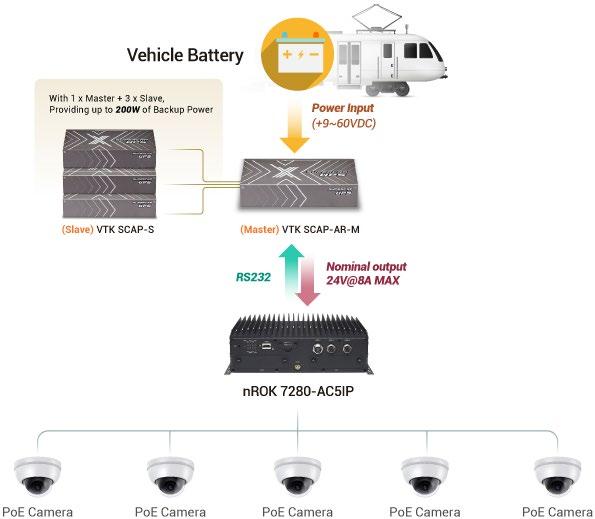
providing a steady 24VDC to the nROK 7280-AC5IP. Positioned between the train’s battery and the nROK 7280-AC5IP, the VTK-SCAP first receives power from the train, regulates it and then outputs a stable supply to the system while simultaneously charging itself. Beyond power delivery, the nROK 7280-AC5IP actively monitors railway power stability via RS232, detecting fluctuations and responding accordingly. If the train stops and the main power remains off for an extended period, the nROK 7280-AC5IP detects the sustained power loss and initiates a controlled OS shutdown, with the VTKSCAP continuing to supply power to prevent abrupt shutdowns and data corruption. To avoid unnecessary system shutdowns due to brief power dips, the nROK 7280-AC5IP only triggers the shutdown sequence after confirming prolonged power loss.
For extended power backup, up to three VTK-SCAP-S (Slave) units can provide up to 200W of additional power, ensuring uninterrupted operations even in harsh environments. Together, this powerful duo not only delivers efficient, reliable and streamlined performance for railway surveillance systems but also triumphs over the Great Train Robbery of tech inefficiencies and instabilities.
The NEXCOM nROK 7280-AC5IP and VTK-SCAP combine advanced features for optimal performance in demanding environments. Powered by 26 TOPS AI computing, the nROK 7280-AC5IP enables AI-powered cameras to support key applications such as passenger counting for occupancy monitoring, optimising load distribution and service planning, and real-time safety surveillance. It detects anomalies like fights or medical emergencies, reducing manual inspections and operational costs. The system includes 4 x 2.5GbE (IEEE 802.3at/af) and 1 x 2.5GbE (IEEE 802.3at/af/bt) ports. The latter is specifically designed to support advanced cameras, including 360-degree views, PTZ (Pan-TiltZoom) cameras and IR (Infrared) cameras, which require higher power consumption. Installation is simplified with M12 X-coded PoE ports, delivering both power and data through a single cable. Additionally, it supports three dedicated drives: one for the operating system and VMS software, and two for storing surveillance footage, which can be configured in RAID to ensure the security and integrity of critical image data, further enhancing both operational efficiency and passenger safety.
On the power side, the VTK-SCAP ensures reliability with its SuperCap-based backup solution, offering over 500,000 charge/discharge cycles for long-lasting durability. With up to 200W of expanded power and operation in temperatures ranging from -35°C to 80°C, the VTK-SCAP ensures uninterrupted power, even in extreme conditions.
Ready to elevate your railway surveillance systems and capture the tech struggles bandits with this all-in-one, reliable solution? Contact us today to learn how this perfect combo can revolutionise your operations, putting an end to the Great Train Robbery of inefficiency!

nROK 7280-AC5IP
Intel® Core™ Ultra, Meteor-lake H, AI In-Vehicle/Railway Telematics Computer
• IP67 rating protection
• Up to 26TOPS AI computing power
• Fanless design w/ operating temperature -40°C~60°C
• 1 x 2.5GbE PoE++ and 4 x 2.5GbE PoE+ X-coded ports
• Power input 24VDC or 24~110VDC with isolation
• CE/FCC, UKCA, EN50155, EN45545-2 and MIL-STD-810H certified


VTK- SCAP-AR-M / VTK- SCAP-S
SuperCap BBU for Railway Application
• SuperCap BBU for railway application
• High power density EDLC (electric double layer capacitor) technology
• Over 500,000 cycle life (charging/discharging)
• Operating temperature: -35~80°C
• RS232 for communication
• Max. expansion 1 x master + 3 x slave
Watch our video to find out more about the VTK SCAP.





































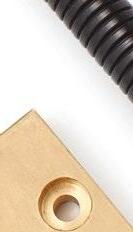


























































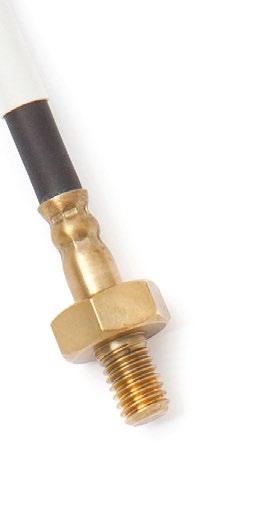
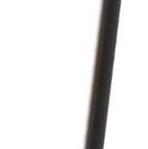
























































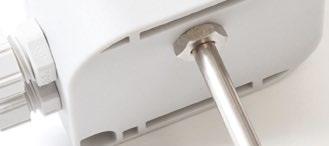





















Proven Tier 1 monitoring technology supporting rail operators since 2018
Integrating CableGuardian into renewals offers several advantages:
—
At project inception, the CableGuardian portal maps assist with FSP location, cable length calculations, and scope visualisation.
Optimise Feeder Material Costs —
Measurement data trends, like feeder voltage and current, help inform legacy feeder design.
Renewal Prioritisation —
CableGuardian data helps prioritise the feeders due for renewal based on condition.
Enhanced Assurance —
CableGuardian ensures assurance across survey, construction, commissioning, and handover.





Blanket renewals, which involve replacing entire systems based on age or estimated lifespan rather than specific non-functioning components, are the usual approach for maintaining safe railway operations.
However, blanket renewals fall short in terms of value for money and sustainability and for minimising service disruption, all of which are critical to meeting Network Rail's CP7 KPIs.
Condition-based spot replacements offer a new solution. Identifying which trackside parts, such as cables or transformers, to be switched reduces costs and limits operational disruption while maintaining safety and maximising efficiency.
In addition to the challenges already highlighted, traditional renewals are often:
• An inefficient use of human resources: a larger project team is required to replace entire systems
• Logistically complex: executing wholesale signalling power renewals leads to complex logistical challenges, such as widescale track closures and the need to commission specialised machinery
• A missed opportunity for rail asset managers to gather and benefit from real-time, data-driven insights
By contrast, spot renewals are resource and costefficient and improve safety and efficiency. A system
like Viper Innovations’ CableGuardian facilitates spot renewal.
CableGuardian enables targeted replacement through advanced diagnostics that proactively monitor degradation over time. It provides early warning of graceful decline and detects sudden faults in live signalling power systems. It integrates insulation resistance (core-to-earth) measurement and spread spectrum time domain reflectometry (SSTDR) (core-tocore fault detection).
By pinpointing specific assets that require attention, CableGuardian ensures minimal intervention using a tiered approach – Tier 2 for feeder-level insights and Tier 1 for more detailed insights into individual cables and trackside equipment housings or groups of equipment along a feeder. This allows rail engineers to target critical components effectively, improving safety, value for money, sustainability and reducing service disruption.
Rail asset managers can be more proactive around maintenance while leveraging real-time data to improve cost efficiency and reliability.
CableGuardian by Viper Innovations

The Western Route faced repeated issues around the Yatton area. Rail asset managers initially considered a complete cable replacement. However, CableGuardian's precise assessment showed that the faults were isolated to specific system sections. This meant that repairs need only focus on affected parts, avoiding the cost and disruption of a complete renewal.
CableGuardian's continuous monitoring predicted and prevented issues early, saving costs over the system's lifecycle. The temporary deployment option allowed for informed decisions without a full upfront investment, supporting budget-friendly decision-making.
The successful implementation at Yatton demonstrated how targeted renewals, backed by accurate diagnostics, can replace costly blanket renewals.
Implementing condition-based spot replacement with CableGuardian is simple and can often be planned during less disruptive times, minimising operational impact. The implementation process is as follows:
1. Install CableGuardian
Deploy and non-intrusively connect the system without needing to shut down the 650V power supply, ensuring minimal disruption.
2.Monitor in real-time
CableGuardian offers continuous, real-time monitoring with advanced diagnostics that use insulation resistance measurement and SSTDR to locate faults in signalling power systems.
3.Target repairs
Use insights from CableGuardian to plan and execute targeted interventions at different levels, including Tier 1 and Tier 2 condition-based assessments.
Budget limitations and caution may mean that rail asset managers want to deploy new systems temporarily for condition-based maintenance before committing to full-scale deployment. Viper Innovations
offers a consultation option to address this concern, helping rail asset managers assess the feasibility and potential benefits of CableGuardian in a real-world setting.
Unlike some alternative systems, CableGuardian provides reliable fault detection and accurate diagnostics, offering clear, actionable insights. There is nothing worse than spending valuable time using a system that provides insufficient, unclear or incorrect data, leading to repeated and unnecessary work, especially in challenging environments like trackside areas. With its wide range of measurements and reliable insights, CableGuardian ensures system condition assessments are made efficiently and are right the first time, enabling areas that require spot renewals to be identified effectively.
CableGuardian provides a data-driven approach to capital works on signalling power systems that focuses on safety, efficiency and sustainability. Its continuous monitoring of key parameters, like insulation resistance and voltage drop, help teams find and fix issues while keeping services running. Temporary deployment options allow rail asset managers to use Tier 1 and Tier 2 condition-based assessments to evaluate system performance before committing to a permanently installed CableGuardian system, if they wish.
The benefits of adopting CableGuardian are clear: less disruption, optimised resources and increased reliability. By basing decisions on condition assessments, CableGuardian moves asset managers away from costly blanket renewals to more strategic, budget-friendly solutions.
This new renewal approach is resource-efficient, enabling teams to do more with less.
Learn more about Viper Innovations’ CableGuardian by visiting our website.




Wild Ingenieure is a survey firm that specialises in railway construction projects in Switzerland. The firm is well known for its progressive mindset that has helped its customers, both public and private, resolve some of rail’s most complex challenges.
We asked Florian von Matt, the Küssnacht am Rigibased firm’s rail monitoring expert, about industry challenges and the role of new monitoring tools, such
as Trimble’s purpose-built Trimble® 4D Control™ (T4D) Rail software module, in meeting growing demands.
Q: Have your company's monitoring services/ requirements changed over time?
A: We have always specialised in rail surveying, so that has not really changed. What has changed is the growing need for ever more accurate and timely monitoring services. With ever-evolving regulations, emerging technologies and great need for infrastructure improvements, our surveying
and monitoring services are greatly in demand. Construction is everywhere and not just railroads, but also roads, bridges and buildings. In each of these conditions, there are concerns about movement.
Q: How and why have you invested in T4D Rail?
A: We have relied on monitoring solutions such as Trimble total stations and T4D Control software for several years. One of the challenges has always been the time-consuming process of getting from collected as-built data to the final results. On a big project, this could take several days. T4D Rail greatly improves that process.
We collect the as-built data with the Trimble Access™ Track Gauge Survey app and from there everything is streamlined through T4D Rail. For instance, we used to do offset and parameter calculations manually; those are now automated through T4D Rail. The module produces deliverables such as calculated parameter values as well as rail-specific visualisation graphs that are easily digestible. Everything is now faster and more streamlined – what used to take days, now takes hours. It’s also helpful that T4D Rail adheres to the strict Swiss Federal Railways standards.
Q: How does the Track Gauge Survey app help with monitoring projects?
A: We have a GEDO system, but largely relied on a track
bar previously to collect data, since rail monitoring projects usually span hundreds of metres of track. We decided to get the Track Gauge Survey app since it integrates well with the T4D Rail module. With this app, the as-built data can be exported with a simple click and then imported into T4D Rail to automatically calculate the offsets between measured prisms and rail points, which in our case must be used for parameter calculations.
Q: How many projects have you used the T4D Rail on thus far and what has been the benefit?
A: We’ve used it on several projects this year. The first was a fairly straightforward monitoring project to monitor about 80 metres of track on top of a railroad bridge. The bridge was built in three different stages, with two tracks in continuous operation. These two tracks had to be monitored during the construction work on the bridge. Because the railroad line is very busy, the work had to be carried out mostly at night
TA Track Gauge App is used in Trimble Access, so the installation can be done in the Installation Manager. The structure of the app is based on Trimble Access (user interface, labels, etc.), so no training or long start-up time is required to work with it. There are not many different settings to make, so few application errors can occur.

and in short intervals. Unfortunately, we were only able to carry out the last monitoring stage with T4D Rail.
After the last tamping works of the tracks, the monitoring had to be installed and measured immediately. The data collection was not executed with the Trimble Access Track Gauge Survey app but with another tool. We had a few errors, but the Trimble support team was able to prepare the correct data for us.
After that, the data was imported into T4D Rail and both tracks were analysed and monitored from that moment on for the whole construction phase.
In the second monitoring project, we were tasked to monitor rail tracks for Swiss Federal Railways near a construction site for several weeks. We set up five total stations near the existing rail to monitor movement and used the Trimble Access Track Gauge Survey app to collect and T4D Rail to manage and analyse the data.
T4D Rail is easy to use because we only have to import one file (track file), with which all needed values are calculated. Nothing has to be calculated independently.
As with all projects, the important part is the data collection process. If this is not done correctly, there will also be problems with the import into T4D Rail. Before T4 Rail, all values had to be defined with calculation sensors. In this project, around 100 profiles were monitored. Without T4D Rail, the setup would have taken us around two to three days.
In this case, we did that entire setup in one morning. Data collection was five night shifts of four hours. Setup was one day for everything, including plans and protocols (pictures in T4D, alerting scheme, alarm definitions, etc.). It’s like using a smartphone, it's just really easy and very, very fast.
Q: Any specific features that you particularly like in T4D?
A: I especially like the detailed rail track geometry charts. They are automatically created based on the collected rail track geometry parameters. The automatic visualisation of the configured thresholds

in the chart views is just great for seeing movement changes. I used to do this step manually. Now, it's just one click, and I see the data for the whole monitoring system.
Q: Are you realizing a measurable ROI from the adoption of T4D Rail?
A: With this technology, I believe we can spend more time focusing on the data analysis thanks to the automated charts and faster setups, and we also spend less time in the field gathering data. That’s a big advantage in providing quality services to our customers. It also allows us to take on more monitoring projects that perhaps we wouldn’t have had time to do in the past.
If you would like to talk to someone from Trimble about the benefits of using the Trimble 4D Control Rail module, contact us here.




Afreight train hauls thousands of tonnes across a frozen landscape, the steel contracting with every kilometre. In the depot, a high-speed train is prepped for another run, its motors humming under the strain of acceleration and braking cycles.
Deep underground, a metro system pulses with the relentless stop-start motion of rush hour, its wheelsets grinding through tight curves.
To the naked eye, everything is running smoothly. But in the bearings, gearboxes and axles, something else is
happening. A barely perceptible rise in temperature. A shift in vibration patterns. The first whispers of wear.
For decades, rail maintenance has been a waiting game. Teams check components, listen for anomalies and hope they catch problems early. But problems don’t wait. Bearings can fail mid-run. Gearboxes can grind themselves apart between scheduled inspections.
A wheel defect that starts as a faint vibration can become a critical failure at 300km/h.
The industry is waking up to a new reality: the tracks are speaking. And the smartest operators are listening.
Mechanical failure doesn’t happen in an instant. It’s a slow, inevitable build-up of stress. A bearing runs hotter than usual. A gearbox starts vibrating in a way it never has before. The warning signs are always there. The challenge has been detecting them in time.
Now, sensors embedded in rolling stock are making it impossible to ignore. Wireless nodes track wheelset vibrations as they happen. Wired condition monitoring systems detect anomalies throughout the entire bogie, from the wheelset to the drivetrain, and even track shocks and damages. These systems also enable digital noise mapping, pinpointing noisy curves and automatically identifying areas to target for reducing urban train noise. It's a smart, seamless way to make our trains quieter and our cities more peaceful.
This isn’t just monitoring – it’s providing insights into the state of the equipment. SKF Insight Rail, a self-powered wireless sensor, catches bearing and wheel damage before it spirals into a breakdown. SKF IMx-Rail, an advanced vibration monitoring system, detects rail track damages as well as gearbox, traction motor and axlebox failures long before the train hits the depot. Also, when the train is equipped with microphones it can provide digital noise mapping. Operators aren’t reacting anymore. They’re getting ahead of the problem.
Rail operators now have access to more data than ever. Every train, every axle, every rotating component is feeding live information into digital systems. But raw data means nothing without action.
Take a metro operator battling excessive wheel wear. Before, maintenance teams waited for complaints about noise and rough rides. Now? Digital noise mapping flags the problem before passengers even notice. Engineers adjust lubrication schedules. Rail grinding is optimised. The fix happens before the issue becomes a crisis.
Elsewhere, a high-speed network spots an emerging vibration pattern in a fleet of traction motors. SKF IMx-Rail confirms it: an early-stage defect is forming. No guesswork – just hard data. The trains stay in service, but the affected units are scheduled for maintenance before a failure forces them out of operation.
Freight operators, dealing with the brutal physics of long-haul loads, are pushing their overhaul intervals further than ever. SKF Insight Rail provides real-time bearing health updates, eliminating unnecessary replacements. Instead of tearing down perfectly good components, they only intervene when the data says it’s time.
This is what condition monitoring does: it turns information into decisions.

Tracking faults is one thing. Predicting them with precision is another.
The digital thread is closing that gap. It connects realworld sensor data with AI-driven analysis and SKF’s decades of engineering expertise.
It’s a feedback loop where every bearing, every gearbox and every wheelset contributes to a living database. Machine learning detects faults, but more importantly it learns from them. The result? Operators see problems coming and know exactly when and how to act.
Instead of wondering ‘Is something wrong?’, maintenance teams are asking ‘What’s the risk, how long do we have and what’s the best move?’.
And it doesn’t stop there. The digital thread extends beyond the train itself, influencing supply chain decisions. With real-time condition data, spare parts logistics can be optimised, ensuring the right components are available before they’re needed.
No overstocking, no emergency shortages – just smarter inventory management based on actual fleet conditions. Operators can forecast demand more accurately, reduce waste and cut unnecessary costs while keeping trains running without disruption.
Not all railways operate in predictable conditions. Some deal with subzero winters where steel becomes brittle. Others battle relentless heat that eats away at lubricants. Coastal networks face a constant fight against corrosion and salt exposure.
Failures in these environments don’t come with a warning. A traction motor seizing in extreme cold can shut down an entire line. Bearings running too hot in the desert can accelerate wear beyond safe limits.
Ignoring the warning signs isn’t an option.
SKF systems are built for this reality. Vibration
monitoring detects heat-stressed components before they seize up mid-run. Coastal rail operators use SKF Insight Rail to track corrosion-prone wheelsets before salt does its worst.
For railways operating under extreme conditions, condition monitoring is the key to staying ahead of mechanical stress and avoiding costly disruptions.
A decade ago, maintenance was about fixing what was broken. Today, it’s about ensuring things don’t break in the first place and reducing maintenance efforts to when they are actually needed.
Rail operators moving to condition monitoring are seeing the results:
• Fewer service disruptions
• Longer asset lives
• Lower lifecycle costs
• Maximum fleet availability
Rail operators are moving towards condition monitoring to cut failures, reduce costs and improve reliability. For those ready to make that shift, SKF’s digital solutions provide the visibility, intelligence and predictive power to keep rail fleets running stronger, longer and smarter.
Your fleet is talking. Every wheel rotation, every gearbox shift, every bearing in motion – it’s all data.
The difference between running smoothly and breaking down is knowing how to use it.
SKF gives you the power to read the signs before they become problems, act before failures hit, and run your operations with total confidence.
Stop following the old rules. Redefine rail maintenance.
Talk to SKF and take control of what’s ahead.


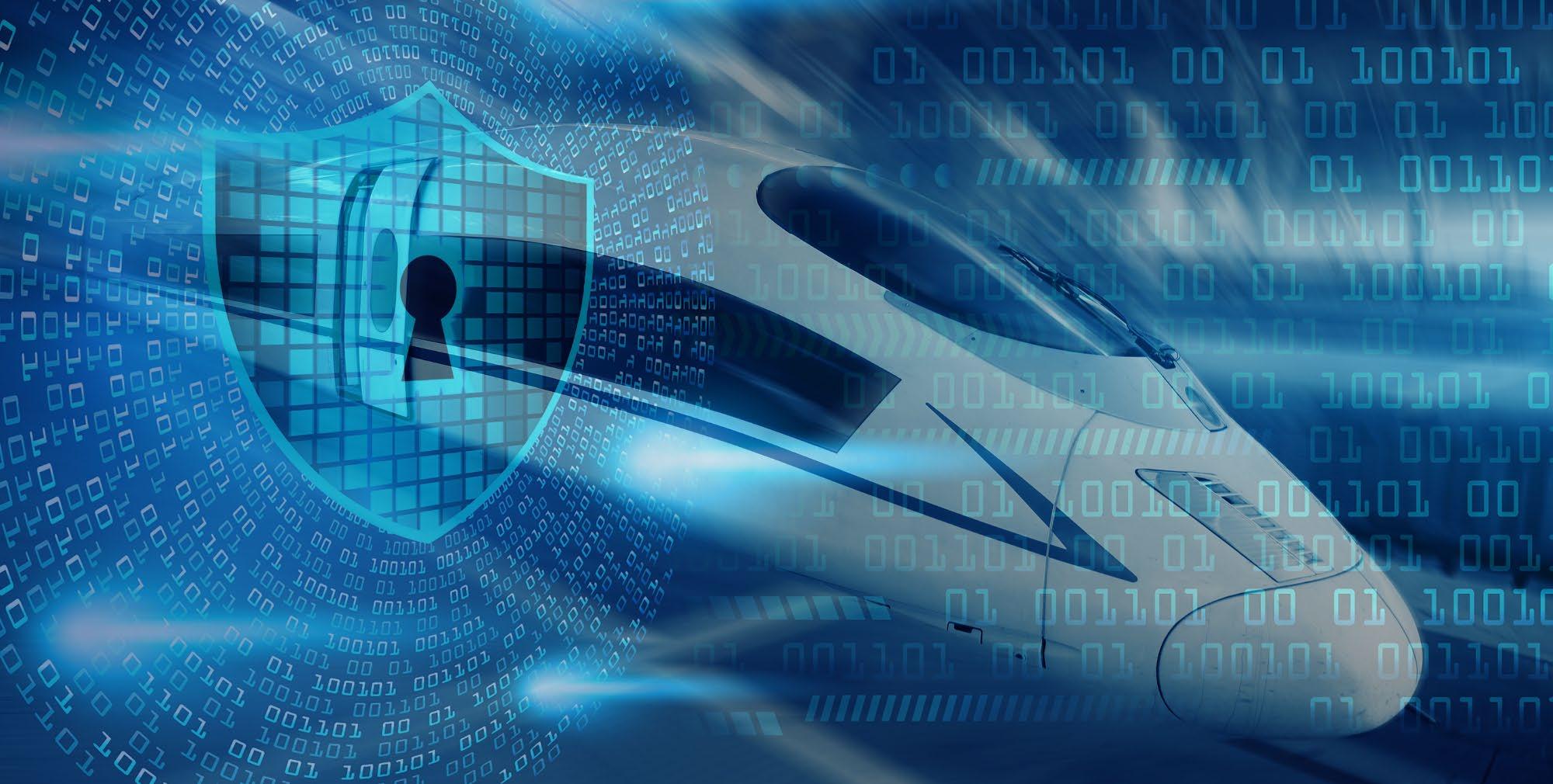
The rail industry is a critical component of the global transportation network and is a significant part of most countries' critical national infrastructure.
As the industry undergoes rapid digital transformation, advances in technologies such as automated signalling systems, Internet of Things (IoT) devices and cloudbased operational platforms, are reshaping and revolutionising rail network operations. Across the business world – and particularly in rail, technology is becoming increasingly complex and interconnected.
Network-based services that help operators to improve their passengers’ experience whilst also adding value to their fleet operations are an increasing part
of the landscape, but as we expose more services to the public, there must be an increased focus on cybersecurity and protection to ensure that services do not present opportunities for vulnerabilities to be exploited.
The number of complexities and severities of cyber attacks on all industries, including rail is increasing rapidly. Sophisticated toolkits can be easily obtained which could potentially allow relatively inexperienced people to conduct complex cyber attacks which can lead to loss of service, data and revenue and to reputational damages.
Having said that, not all attacks on IT infrastructure rely on sophisticated tools or advanced technical skills – during the 2024 Paris Olympics, the rail network
experienced a significant attack designed to disrupt the games and deliver press coverage worldwide. In that case, the attack was on physical network infrastructure which halted major parts of the rail network.
As cybersecurity threats have evolved, various standards and guidelines continue to emerge to help safeguard critical infrastructure. However, solution providers often face challenges in determining which standards to follow. Some of the most significant include:
• The NIS2 Directive (Network and Information Systems Directive 2) aims to enhance the cybersecurity and resilience of critical infrastructure and essential services across the European Union. Building upon the original NIS Directive (2016), NIS2 addresses the ever-evolving cyber threat landscape by expanding the regulation scope, introducing tighter security requirements, and supporting cooperation among EU member states.
• The EN62443 series of standards for industrial control systems has been widely recognised as useful within the rail industry, even though it is not specifically focused on rail transport. It provides a very comprehensive framework for all elements of system design, development, component supply chain, manufacturing, testing, deployment and maintenance.
• The EN50701 standard has been proposed by a broad group of rail industry suppliers and operators (also referred to as TS 50701) which acts as a rail specific variation of the EN 62443.
Governments are also taking proactive steps to combat cyber threats. Governmental and national bodies have long been considering laws to improve the cybersecurity of organisations and protect the rights of individuals. The European Union has recently released the Cyber Resilience Act (CRA) with its goal being to enhance the cybersecurity of digital products. The CRA requires manufacturers selling products to EU member countries to embed security features into products from the design and development phase, commonly
known as ‘security by design’. Included in the act is the requirement to provide, free of charge, regular updates and patches to fix potential vulnerabilities.
For train operators, this means increased visibility into the security of their digital infrastructure. Leading operators will likely establish – or already have processes to review security updates and assess their impact on fleet safety. Those without streamlined software upgrade procedures may need to refine their change management processes to maximise the benefits of CRA.
At Nomad Digital, we are committed to helping train operators strengthen their cybersecurity posture and protection. By working proactively with industry stakeholders, we aim to ensure that rail networks remain secure, resilient and prepared for the challenges of an increasingly connected world.
Nomad Digital's Security-as-a-Service offers a comprehensive approach to cybersecurity that goes beyond a 'software-only' solution to aid the detection and response to an actual or suspected cyber-attack as well as enhancing important security processes such as risk & vulnerability management.
Speak to Nomad Digital’s experts today to find out more. You can also find Nomad Digital and Alstom at The Rise of IoT & Big Data in Rail Event 14–15 May 2025, Cologne.


For more information visit our website or contact our team.

24/7 monitoring to enhance threat detection and response to cyber-attacks
Visit Nomad Digital & Alstom at ‘The Rise of IoT & Big Data in Rail’ event 14-15 May 2025, Cologne
Alstom, a world leader in mobility solutions, actively shapes and implements rail cybersecurity standards. With over 20 years of experience, Nomad Digital offers secure connectivity solutions for rail. Together, Alstom and Nomad Digital deliver state-of-the-art cybersecurity solutions tailored to the rail industry.







High-precision measurement of smallest vibrations in vehicles and infrastructure is a basic requirement for safe, comfortable, productive rail transport. Inertial sensors play a key role, therefore global manufacturers have been relying on accelerometers, gyroscopes and inertial measurement units from ASC Sensors.
With its expanded RAIL sensor series, ASC is now further advancing the railway industry. Specialized models, such as the compact ASC RAIL-x151LN accelerometers and the ASC RAIL-27x1 gyroscopes, are setting new standards in railway safety, capacity and efficiency.
All ASC RAIL sensors are robust, flexible and precise – designed to withstand the toughest challenges. Certified to applicable norms including EN 50155, EN 50121-3-2 and EN 45545, they provide reliable solutions that meet national and international standards.
Through ASC’s comprehensive portfolio of MEMS-based acceleration and gyroscope sensors, railway operators can easily implement customized sensor solutions while reducing documentation requirements.
The outcome:
• enhanced safety
• increased productivity
• and stable long-term performance of rolling stock.




ASC inertial sensors are used for
Characterization of track geometry (EN 13848)
Specifying structural requirements for bogie frames (EN 13749)
Dynamic interaction between pantograph and overhead contact line (EN 50317)
Passenger ride comfort (EN 12299)
Running characteristics of railway vehicles (EN 14363)

Data & Monitoring
Certification
German inertial sensor specialist ASC Sensors and Spanish test and analysis centre CETEST have been collaborating to address critical measuring and evaluation challenges, providing unrivalled monitoring outcomes to railway manufacturers and operators across the world.
CETEST, an independent technology testing and analysis specialist, provides advanced engineering, testing and monitoring services. Accredited to ISO17025 and based on a more than 30-year legacy in railway technology evaluation, the company has been helping leading global rail manufacturers including Alstom, CAF, Hitachi, Siemens and Stadler through relevant regulatory approval processes for new and refurbished vehicles, individual components and systems around the world.
One area in which the Spanish testing lab has developed industry leading expertise is the critical interaction between pantographs and overhead lines. This aspect is key in the validation of new rolling stock to run on existing infrastructure, as well as in approving new infrastructure designs. It also bears a significant impact on maintenance costs.
Uniaxial ASC 4421MF accelerometers play a pivotal role at CETEST in evaluating pantograph performance as



well as rolling stock ride comfort and dynamic behavior. Based on proven MEMS technology and capacitive operating principle, they feature a broad measurement range of 2 to 200g. The integrated electronic circuitry enables a differential analog voltage output (±2.7V FSO) and flexible power supply voltage from 5 to 40VDC. ASC’s medium-frequency (MF) accelerometers provide a wide frequency response range of 0Hz to 7kHz (±3 dB) and an extremely robust design with shock resistance up to 6,000g.
“We’re using ASC’s accelerometers in a special precision instrumentation system for pantograph contact force testing at train speeds exceeding 350 km/h,” says Carlos Carmuega Tena, Quality Director
at CETEST. The ASC MF4421 is employed to measure vertical acceleration in the pantograph.Based on these measurements, the inertia forces due to effects of the mass of components between the sensors and the contact point get corrected.
For these testing series, the sensors are installed between the pantograph body and the contact strip. The latter is in direct contact with the catenary and represents, therefore, a high-voltage area. “Not only does this position lead to high heat exposure to due to the voltages used,” the expert explains, “they also cause plenty of electromagnetic interferences.And the extreme exposure of this demanding sensor application to noise, vibrations and harsh environmental conditions (NVH) like heat,rain and ice plays an even bigger role in obtaining accurate,stable results.”
To resist all that, the uniaxial ASC 4421MF series features a reliable lightweight aluminum housing of protection class IP67 and an integrated cable of configurable length with connectors. Its ultra-flat design allows for convenient installation, a fundamental requirement in pantograph testing as the position, size and weight of the sensors used are of particular relevance for the validity of the tests results.
“When we evaluated accelerometers of different makes previously,an issue we encountered was that those were easily damaged by the high voltages,” Carmuega Tena remembers. “Using ASC’s robust sensors,we can now avoid electrical problems due to voltage and obtain good quality signals,despite electromagnetic interferences and other external conditions.”
“While our collaboration with ASC Sensors started because of their accelerometers’superior behaviours in our pantograph tests,we soon expanded into additional uses,” reflects the CETEST engineer. “Another decisive advantage was the convenient compatibility of ASC’s sensor technology with our existing instrumentation and measurement data processing ecosystem.Its competitive pricing,delivery


times,compact dimensions and ease of installation also turned out to be a great fit.”
Therefore, after rigorous evaluations of various alternative sensor models, CETEST started leveraging the ASC 4421MF accelerometer in dynamic behaviour and ride comfort analyses, too. “We’re also using them in brake tests for measuring the acceleration and deceleration of the train. As well as in investigations into specific issues occurring in active trains post approval,” Carmuega Tena explains. In addition, the MEMS-based uniaxial ASC QF-1211 accelerometer, with ultra-low noise level and a resolution of less than 1µg, serves as a calibration reference at CETEST, ensuring superior testing accuracy. While triaxial ASC 273 gyroscopes get utilised to accurately determine curve radii in various speed and acceleration analyses, which a new train model needs to pass to get approved for active service.
With these and further applications, some trains evaluated by CETEST carry more than 50 individual sensors manufactured by ASC.
“Beyond the technical quality of their flexible sensor solutions,what’s impressed us over time is the sheer dedication and outcomes orientation of ASC’s engineers,” reflects the CETEST expert.“When I ask for a sensor,they ask me for the application.On that basis,they typically come back with tailor-made recommendations for a complete solution addressing our specific challenge.While usually,with other suppliers,we would have to accept a standard product.”
www.asc-sensors.de

Driving efficiency: how digital platforms are revolutionising work bank planning at Network Rail.
Rail BI is on a mission to revolutionise the way railway infrastructure managers handle complex data. By consolidating data sets from multiple sources into a single, coherent platform, the company enables sophisticated cost decision-making for rail infrastructure projects, taking the pain and guesswork out of business case production.
A recent beneficiary is Network Rail, which moved from outdated, error-prone spreadsheets to a modern, cloud-based solution that resulted in significant cost and time savings, increased scalability and improved collaboration across teams.
“Our tool has helped Network Rail transition from a labour-intensive spreadsheet that only one person could edit at a time,to an application that supports multiple users interacting simultaneously,” explains Adam Medley, Head of Operations at Rail BI.
“At the moment,we’re working with the company to help them with asset work bank long term planning and cost forecasting for signalling and level crossings.”
With the Rail BI cloud-based tool, all calculations are carefully validated so it's very hard to make mistakes; it can also check to ensure that the data has been entered in the correct form. Its streamlined and errorchecked operation has already saved Network Rail a significant amount of time by removing the need to manually maintain a spreadsheet.
“Automating workflows in spreadsheets required

Daniel Paxton, Senior Engineer (Signalling Policy & Asset Management), Network Rail, agrees: “The difficulty in keeping the spreadsheet up to date and making it user friendly limited trust in the system by users.This resulted in more time being spent on costing,and adjustments being made outside the system with less transparency of what the drivers were. The old system had come to the end of its useful life and we began to look at alternatives.”
Also, due to its limited reporting and analytics, Network Rail was unable to extract the full value from its signalling and level crossings assessment data. Now, the Rail BI platform combines asset information and work bank policies to generate a long-term renewal and upgrade plan for the network. Users can make changes to the plan and any downstream effects are immediately visible.
“Digital signalling costs are calculated using hundreds of metrics, based on thousands of different assets across a designated area to get very detailed estimates in very little time,” explains Medley. “As well as the savings,we’re able to produce a level of complexity and detail previously impossible.”
Rail BI had already worked with Network Rail to develop business cases for resignalling some locations with in-cab signalling for the European Train Control System (ETCS).
“I gave some work bank planning input and they developed the capability to include all kinds of signalling interventions to better model different ETCS deployment scenarios,” Paxton explains. “This presented us with the opportunity to adopt the system for the regional engineers and to support our assurance,and eventually replace the spreadsheets.”
Other systems were being developed around the same time but a review revealed that Rail BI was best placed to quickly respond, as a contract with Network Rail was already in place.
“In the longer term,we concluded that continuing with Rail BI was the best choice,given their successful delivery,agile approach and value for money,” says
Paxton.“This was also better than spending a lot of time and effort with a new system reproducing the user interface already developed.”
The solution supplied by Rail BI also covered networklevel planning and forecasting. “I’m confident this saves time for asset engineers,as they otherwise spend a lot of time gathering information needed to plan renewals, and the result should be a better quality work bank in a shorter time,” Paxton explains.
Asset engineers can now plan their work bank with all the information they need to make high level decisions available in one place, and quickly see any limitations to their plans, as well as the likely cost and volume to be delivered over time.
Network Rail’s CP6 Delivery Plan, which ran from 1 April 2019 to 31 March 2024, required a new approach to cost forecasting. “We needed to make it more accurate at local level,due to the change to regional accounting, and the reclassification of Network Rail as an armslength public body,which introduced stricter financial rules,” explains Paxton.
“We moved it onto the Rail BI platform and the result was much better.We went from delivering little more than half the planned volume for CP5 for the same spend,to delivering CP6 very close to the planned rates overall.This formed a good foundation for CP7,which is now in delivery.”
Such has been the success that Network Rail is keen to deploy Rail BI’s solution to other disciplines to enable it to maximise economies of scale and improve the planning and reporting of multi-discipline projects.
Rail BI is already expanding the platform to support ETCS train fitment planning, which is closely related to the signalling work bank.



Data & Monitoring
Real-time information systems are essential for improving passenger satisfaction, operational efficiency and safety in the rail industry, writes Thomas Auner, CSO and Partner, cn-mobility.
Today, train operators and passengers alike expect instant access to accurate, up-to-date information to ensure smooth journeys and a seamless customer experience. Whether it’s updates on delays, platform changes or service disruptions, real-time communication has become a necessity – not just for convenience, but also security and trust.
This evolution in expectations demands modernisation, and cn-mobility is at the forefront of these advancements. Our vision is a world in which travelling by train is a pleasure for everyone.
By prioritising software intelligence and leveraging open interfaces, our solutions ensure flexibility, scalability and compatibility across rail systems. Gone are the days of relying on proprietary hardware and exclusive communication protocols. Instead, our approach integrates cutting-edge technologies to meet the dynamic needs of today’s rail networks.
Until recently, cn-mobility’s solutions incorporated components from various hardware manufacturers. However, we decided to no longer wait for others to improve their products, but instead take action ourselves. We brought in-house a team of highly experienced engineers, which has enabled us to develop our own complete audio solution. This was launched in February.

There’s always been this antiquated idea that you need a separate device for each purpose, but we see things differently. With this in mind, our team developed the InnoCom PD audio amplifier, which can be supplied in combination with a driver intercom, saving hardware and costs.
Our multifunctional electronic announcement system device (amplifier and cab unit) enables seamless integration of multiple audio components for easy communication between staff and passengers.
Until now, you had to buy what was available – there was nothing to configure, to choose or to expand, which is why we created a highly modular and flexible design for our amplifier. This can be configured to individual
• Reliable power supply: the configurable and redundant power supply guarantees a reliable power supply in a wide voltage range from 24V to 110V, which increases flexibility and safety in various application scenarios.
• Built-in fail-safe: interruption class S2 (10 ms) in accordance with EN50155 ensures that short power interruptions are bridged without system failure, which increases operational reliability.
• Flexible ethernet-network: the configurable redundant ethernet network enables a reliable and adaptable network connection that meets the requirements of modern communication systems.
• Versatile I/O configuration: the 10 galvanically isolated and configurable I/Os offer flexibility when adapting to specific application requirements, whether as digital inputs, 24V outputs or push-button inputs.
• Digital inventory: with the digital type plate, you not only have the ability to retrieve important information remotely at any time, but also to transfer this directly to an ERP system. This makes service, troubleshooting and inventory more efficient and fully digital. The seamless connection to your company systems saves time and resources, while at the same time optimising your processes.
• Meeting the ‘right to repair’: in line with the EU-Directive 2024 / 1799, which will be a law in each EU member state by the end of 2026, each part can be easily replaced.
requirements, as well as easily repaired. Furthermore, the device can be completely dismantled, maximising recyclability and improving sustainability.
Our InnoCom PI intercom was developed to create an optimal interface between passengers and staff.
cn-mobility products


It offers advanced echo, noise and interference cancellation to ensure clear communication, especially in demanding environments, in addition to a maximum speaker output transmission of 16kHz (standard: 8kHz). The frequency response is also linearised, which significantly improves speech intelligibility.
The intercom station includes a redundant network




connection and power supply, and to add more flexibility, an external power supply without power over ethernet (PoE) is optional.
A feature we’re particularly proud of is our Auracast standard, which we’ve integrated into our passenger intercoms. Auracast is a relatively new Bluetooth derivative that offers people with hearing impairments the opportunity to listen to an Auracast stream. This might be for announcements from the passenger information system, the train driver or even from the control centre, via a modern hearing aid or headphones.
An added benefit to Auracast is that it works wirelessly, so you don't have to lay a complex inductive hearing loop in a vehicle.
If you’d like to find out more about cn-mobility’s solutions and how they might benefit you, please visit www.cn-mobility.eu or email sales@cn-mobility.eu
• Solid and sustainable: stainless steel housing significantly extends the service life of the components and thus contributes to the conservation of resources. The modular design enables easy maintenance and targeted replacement of individual modules.
• Digital inventory: with the digital type plate, you not only have the option of accessing important information remotely at any time, but you can also transmit this directly to an ERP system, making servicing, troubleshooting and inventory more efficient and completely digital.
• Customisable colours: the audio interface has a customisable colour scheme and pattern selection for the LEDs, which can be adapted to individual preferences or requirements.
• Meeting the ‘right to repair’: in line with the EUDirective 2024 / 1799, which will be a law in each EU member state by the end of 2026, each part can be easily replaced.







































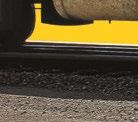

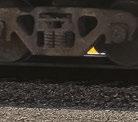
































The Gradall TrackStar’s tilting and telescopic boom, equipped with an array of MOW attachments, handles everything from rail and tie repairs to vegetation control, landslide cleanup, and crossing repair. Even in tunnels and under bridges, the low-profile boom keeps working e ciently. Whether mounted on rough terrain or highway speed chassis options, TrackStar models deliver.
























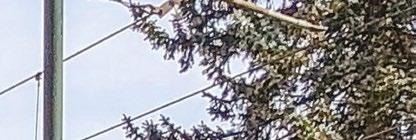









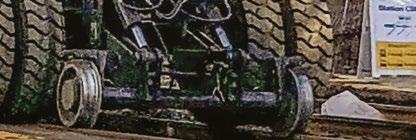


























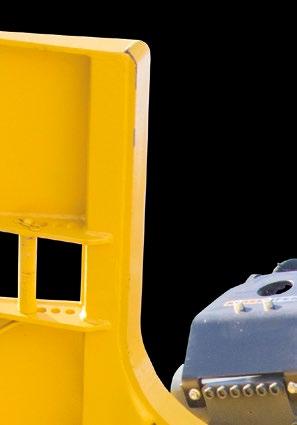

























































Electrification
Mosdorfer Rail Ltd p.46
Worksite Protection
ZÖLLNER Signal GmbH p.49
Depot Equipment
Zonegreen p.52
Maintenance & Equipment
ROBEL p.55
Gradall TrackStar p.58
Dual Inventive p.60
Yeltech Ltd p.63
MAURER MAGNETIC AG p.66
Cabling Solutions
Complete Composite Systems p.69
TXO p.73
Works Vehicles & Machines
Harsco Rail p.76
ZAUGG AG EGGIWIL p.79
Geotechnical Solutions
Argus Fluidhandling p.82
Track & Trackside Materials
Pandrol p.83

Patented Spring Tensioning Device

In the ever-evolving world of railway technology, where the need for efficiency, safety and precision grows by the day, railways are constantly faced with challenges.
One of the biggest hurdles is ensuring that the tensioning systems along the tracks can keep up with the demands of longer stretches and more intricate rail lines.
For many years, the Tensorex C+ system has been the go-to solution. Designed to replace the older balance weight systems, it brings a new level of reliability to both railways and trams, making it a staple in the
industry. The Tensorex C+ handles tension lengths up to 1,116 meters. For many rail lines that stretch far beyond that, the solution just isn’t enough. The question is, what happens when the track stretches further than the original Tensorex C+ system can go?
As the Tensorex C+ nears 20 years of operational reliability and low maintenance, the need for tensioning units that can maintain longer tensioning lengths grows even more. The answer comes in the form of the Tensorex C+ 3D. The new system extends the maximum tension length to 1,616 meters, adding a full 405 meters to the original capacity. This enhanced version delivers a remarkable increase in force and compensation capabilities, resulting in up to a 40% increase in
tension length. This makes it a genuine alternative to traditional balance weight systems, providing enhanced performance and versatility for a wide range of railway applications.
With these advancements, our device now stands as a true alternative to traditional balance weight systems, further cementing its position as a world leader in railway technology. Our commitment to innovation and performance continues to drive us as we aim to meet the ever-evolving needs of railway applications worldwide, offering cutting-edge solutions that elevate the industry’s standards.
The new improved variant of the Tensorex C+ product achieves its enhanced capabilities through innovative optimisation of the spiral springs and pulleys, resulting in increased torsional performance. This advancement is accomplished while preserving the robust mechanical principles that have reliably supported the product for over 20 years in the railway industry.
This new model incorporates our proven higher torque springs, which have demonstrated reliability in our high-tension models, such as the 4SS and 5SL. Additionally, it features a groundbreaking 3-dimensional pulley design that maintains applied torque through more than 360 degrees of movement.
The new 3D product has undergone rigorous independent testing to ensure compliance with both internal and external standards. These tests predict that the endurance of the product will reach the design life of a typical overhead line equipment system. Another key aspect of this product improvement is that 95% of the components in the new Tensorex C+ 3D have a proven track record from our existing range, ensuring reliability and quality. By innovatively



optimising just a few components, we have achieved significant performance enhancements without compromising on the standards that our customers expect.
This commitment to durability and performance positions the Tensorex C+ 3D as a dependable choice for railway applications, reinforcing our reputation for quality in the industry.
In addition to the enhanced performance of the Tensorex C+ 3D, the product offers several key benefits over traditional auto-tension systems:
• Increased levels of product safety
• Higher reliability
• Extremely low maintenance
• More compact and aesthetically pleasing design
• Reduced installation costs
• Virtually immune to vandalism
• Lower life cycle costs
• Proven supply and reliability
These advantages make the Tensorex C+ 3D a spring tension device with unparalleled performance and capability, meeting the demands of modern railway systems. With the availability of this training course, options are now available for extended product warranties on Tensorex C+ units installed by trained personnel. Please contact Mosdorfer Rail Ltd for more information.

Mosdorfer Rail recently developed a new training course in the installation and maintenance of our Tensorex C+ spring-tensioning system.
It is the only Tensorex C+ training endorsed by Mosdorfer Rail; the designer, manufacturer and patent holder of the product. The course is designed to provide a blended learning programme that addresses the key fundamental technical and functional aspects of the Tensorex C+ system.
This course is directed towards competent staff that undertake installation or maintenance railway engineering activities. The course syllabus aims to raise individual standards and awareness of methodologies around the Tensorex C+ system. This includes the installation process, the setting up and the maintenance of the auto-tensioning system. Learners that successfully complete the course will

be awarded a bespoke customised Level 2 award in the Installation and Maintenance of the Tensorex C+ System. This qualification is issued by ETA, a nationally recognised educational awarding body which qualityassures this training product.
The issuing of this Level 2 award will in turn register the individual onto a tracking matrix of the competency award. This concept approach will provide the principal provider with the following assurances:
All Tensorex C+ trained and qualified installers/ maintainers will be placed on a database for internal and external purposes.
• The issued certificate provides a barcode for scanning of trained and qualified staff
• All staff reporting to worksites can be verified prior to work commencing
• Installation activities will be recorded and documented using the issued ITP form
• Standards around the installation will be raised and more accountabilities can be placed on OLE installers
This training course is available now and can be organised via the team at Mosdorfer Rail Ltd. With the availability of this training course, options are now available for extended product warranties on Tensorex C+ units installed by trained personnel.
Please contact Mosdorfer Rail Ltd for more information.




Untilnow, it has been customary to secure track renewal worksites or sites with heavy machines by placing automatic track warning systems along the track at regular intervals.
This requires a large number of warning devices in order to cover the length of the worksite and the progress of work along the track.
Transport policy is changing rapidly in many countries to increase transportation via railway. The surge in rail traffic also increases the risk of collisions for personnel working along the tracks. In addition, a highly frequented route comes with quite a bit of noise pollution if secured with such a large amount of
warning devices. All these factors combined with a push to optimise costs for securing such worksites have led to a need for innovation.
This is why we at ZÖLLNER have spent several years developing innovative solutions considering these requirements. This new way of securing high-output worksites is becoming more widely used in France and Germany.
While the strike-in points, the strike-out points (consisting of a train detector and the ZÖLLNER Radio Transmitter ZFS) and the control units ZRC are still placed along the track, the warning devices ZPW12610 are now mounted on the track renewal trains or other railroad machines. Preliminary tests determined where exactly the ZPW126-10 are to be placed on each
machine to ensure that all workers in the proximity of that particular machine can safely hear the acoustic warning and see the visual signals. The warning devices are therefore placed exactly where the work is carried out and move along with the work progress.
Before, it was necessary to place warning devices all along the worksite accounting for the work progress as well because that was the only way to guarantee an audible warning signal for all the people on the worksite. Since the warning devices now move along with the trains and therefore with the works carried out, much fewer devices are needed to secure the worksite. Drastically reducing the number of warning devices leads to a vast decrease in noise pollution, cuts back the time needed for installation, and significantly saves costs.
It is our goal to offer tailored solutions that fit the exact needs of each customer. The newest generation of our Mobile Radio Warning System MRWS (DAPR) allows for immense flexibility, meaning that each worksite can be secured regarding its specific conditions. The warning devices can either be installed temporarily on the machines for the duration of the worksite or remain there permanently.
We work closely with each customer to design a solution that fits their working methods and type of machine. Since we were thus able to reduce the amount of warning devices needed (and thereby cutting the installation time), lower costs and help prevent complaints by residents near the worksites, our new system has found great acceptance with railway infrastructure managers.

Click here to see how
constructioninstalledonthe machines works when a train approaches


The ZÖLLNER MRWS allows for maximum flexibility.A combination of warning devices installed on the side of the track as well as on the construction train itself keeps every worker safe while minimising the number of devices needed
WADSON, installed in the cabin. As a result, the driver will be able to clearly hear the warning signal as well. Since some work conditions require ear protection that could make it difficult to hear a warning signal, we have developed warning devices which are directly integrated into the protective gear. Our CLARISSystem integrates both the warning signal and voice communication, making it possible for workers to safely communicate while being protected by the warning device at all times.
With many years of experience, ZÖLLNER offers a range of training courses to meet the needs of companies more precisely. In France, ZÖLLNER has been providing training since 2004, meeting SNCF requirements such as the MT4082 manual. All our French trainers are experienced technicians with field knowledge.
In addition, we are continually working on further innovations to make securing worksites even easier, more cost effective and better for all involved. It will thus be possible to equip railroad machines with a miniature device, the
We offer courses for both the management or planning staff who plan the worksites and its safety measures as well as the users of the actual warning systems. A written test and a practical hands-on part ensure that all participants are ready to use the warning devices confidently.
While ZÖLLNER is headquartered in Kiel, Germany, we also have an office and a training facility in Villemandeur, France. If you should ever need help or advice, our hotline is available 24/7.
www.zoellner.de

It’s all change at depot safety specialist, Zonegreen! After 10 months of planning and hard work, the Sheffield-based rail industry supplier has moved to new, stateof-the-art premises that are almost double the size of its previous ones.
Zonegreen, part of the Sentric Safety Group, has relocated to a purpose-built 500 square metre facility within the city’s Davy Industrial Park, which has been its home since 2009.
Rapid development has driven the office move, as a larger space was needed to accommodate the firm’s growing team. In the 15 years it has been based at Davy Industrial Park, staff numbers have increased 125%, from eight to 18 and some 2,700 orders have been received for its depot safety systems, more than 1,000 of those placed in the last four years alone.
The new premises will allow Zonegreen’s design and engineering experts space to demonstrate their technical expertise to customers, whilst also providing efficient workspaces for its support teams.
In January, Zonegreen invited customers and colleagues to see its new premises, holding its very first open day to celebrate the move and showcase its growing success.
Visitors were able to tour the new presentation spaces and engineering laboratory, which will welcome customers for conferences and testing, as well as explore the integrated offices and

warehousing, where its advanced safety systems are designed and built.
Colleagues from Sentric joined the Zonegreen team to greet attendees from a range of companies, including Alstom, RTS and CBRE. Demonstrations were also held to illustrate how the firm’s flagship Depot Personnel Protection System (DPPS) and innovative Points Converter technology work in practice.
Christian Fletcher, Zonegreen’s Head of Engineering, said: “Making this move a reality has required a great deal of time and effort.Customers and products are at the heart of our relocation and we were honoured so many took time out of their busy day to visit us.
“We are really settling into our new premises.They give us the facilities and technology to foster greater collaboration with the wider Sentric family and we will be using the space to continue to grow and develop products that we know can save lives.”
Zonegreen is the world-leading expert in depot protection and interlocking solutions. Its technology is used in the world’s most advanced depots, as far afield as Australia and the Middle East, to reduce the risks faced daily by rail maintenance staff.
DPPS automates safety procedures to remove the margin for human error, allowing the safe and efficient control of vehicles in the depot environment.
Staff using the latest version of the system are issued with contactless RFID cards that can be programmed with various levels of authorisation. When beginning work in an area of risk, they log on to road end panels that prevent Network Rail-approved derailers from being lowered, stopping vehicles from entering the occupied road.
DPPS is one of the safest systems on the market, boasting independent certification to prove its compliance with both the hardware and software requirements of SIL 2 – a reliability assessment of the relative risk reduction. It is also the most thoroughly tested and proven in use, offering a low-risk option to depots looking to improve their working environment.
Pulling manual hand points and the dangers associated with traversing ballast to reach them, are some of the greatest hazards faced by maintenance staff. Zonegreen developed Points Converter to directly address this risk, without causing major expense or disruption for depots.
The technology automates existing manual hand points, allowing them to be switched remotely from a controller located conveniently within the facility. This removes the risks of falls and handling injuries associated with the force required to operate a manual point. It also increases the ease of operations, eliminating many stop/starts from train movements.
Points Converters do not compromise the integrity of manual points and are supplied with an event logging

system that allows the depot manager to keep a record of operations, offering full traceability.
Joining the Sentric Safety Group in 2023 brought Zonegreen together with other international brands and experts dedicated to protecting people in hazardous working environments. This transition has proven to be incredibly successful and is enhancing its reputation worldwide.
Gemma Houghton, Sentric’s Head of Rail, added: “Zonegreen is an excellent ambassador for our group, demonstrating how technology can be used to automate safety procedures,reducing the risks faced by rail maintenance staff.
We are very proud of the progress the firm is making and its new premises reflect the hard work and innovation that is fuelling its growth.”
For more information about Zonegreen’s office move or its range of depot safety systems, telephone (0114) 230 0822 visit www.sentricsafetygroup.com or follow the firm on LinkedIn


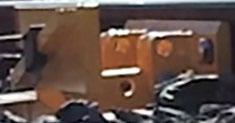

Renowned as the global market leading depot protection system, the SMART DPPS™ delivers physical protection from vehicle movements to rail depot staff whilst providing visual and audible warnings.
The Smart DPPS™:
• Protects staff and equipment
• Ensures safe and controlled movement of rail vehicles into and out of the depot
• Allows train maintenance operations to be conducted without endangering the safety of staff or damaging infrastructure
It is:
• Fully configurable, flexible and functional
• Proven in use and installed globally
• Capable of interfacing with third party equipment including signalling systems.
• Adaptable to the safe requirements of the depot




Railways are the backbone of modern transportation, but keeping them in top shape is becoming a major challenge.
With growing traffic, shorter maintenance windows and a shrinking workforce of skilled rail welders, infrastructure managers are under pressure to maintain reliability and to decrease life cycle management cost.
An advanced robotic welding system is now proving that the future of railway maintenance is smart, efficient and fully automated.
Developed by ROBEL Rail Automation in collaboration with leading railway company ProRail and contractors Strukton Rail and Volker Rail, all from the Netherlands, this cutting-edge technology is set to change the game.
depend on a workforce that is becoming increasingly difficult to find.
That’s where automation comes in. A fully robotic welding system offers:
• Unmatched precision: Robots don’t get tired or make mistakes. Every weld is executed with under millimeter accuracy.
• Faster maintenance: Shorter track closures mean fewer disruptions for passengers and freight.
• Safer operations: Reduced need for human workers in high-risk areas.
• Lower life cycle costs: Fewer emergency repairs by more preventive work.
The idea of robotic railway maintenance isn’t just a futuristic vision – it’s happening now.


Housed in a dual-container unit on a flat wagon, this mobile system can be deployed anywhere on the network. During transport the robot system is characterised as load. In closed track the unit enfolds to a simple working unit performing the job in full shifts, in any weather, and is set to be operated by two workers.
• Scanning maps out the geometrical conditions of the rail or switch frog.
• Precision milling removes damaged material with incredible accuracy and speed.
• Preheating brings the metal up to the perfect welding temperature in minutes.
• Automated welding restores the track, applying layers of material with a flawless finish.
• Final profiling and inspection ensure that the rail geometry is restored, and everything is digitally documented.
The first real-world tests were a huge success:
• Perfect welds: The system delivered highquality, durable welds on both carbon steel and manganese steel.
• Efficiency boost: A single switch frog repair can be completed significantly faster than with traditional methods.
• Minimal manpower: Only one operator was needed to oversee the process supported by one helper.
• Digital tracking: Every step was logged for full transparency and quality control.
This is more than just a cool tech demo – this is the future of railway maintenance, and it will prove its value in the life cycle extensions of the infrastructure.
“The welding robot has future potential,” was one of the conclusions after the welding robot demo days at the Railcenter in Amersfoort.
As partnership is understood as a model to collaborate besides make or buy decisions, next tests and steps are on the way:
• Increasing technical readiness-levels to handle even more complex repairs.
• Expanding technological capabilities of achieving the right switch geometry based on premeasurement data and a model based approach.
• Teaming up for use in different railway networks worldwide.
• Connecting with digital monitoring systems for predictive maintenance.
• Simplified operation, making it even easier for railway teams to adopt and use.
ROBEL Rail Automation is now looking for partners and customers across Europe, the UK and beyond to bring this revolutionary system to more rail networks. The iaf trade show in Münster, Germany in May 2025 will be a perfect occasion to see ROBOT performing welding jobs in switch frogs and to initiate projects for the upcoming years.
The railway industry is at a turning point. Traditional maintenance struggles to keep up with demand, but robotic automation is stepping in to bridge the gap. The first tests of this cutting-edge welding robot show that railway maintenance can extend the life cycle of critical infrastructure and be faster, safer and more reliable than ever before.
Watch our video here. www.railautomation.com/en


Gradall railway maintenance machines represent a unique combination of mobility and versatility, able to get to the job – either on rails or pavement – and then efficiently handle a wide range of maintenance and construction jobs.
Armed with Gradall’s world-famous boom, these machines handle rail replacement and repair, trackside maintenance jobs and right-of-way and crossing work.
Gradall’s full-tilting, telescoping, triangular boom is a legend in railway maintenance and repair, precisely positioning rails and ties, removing vegetation, demolishing concrete, spreading ballast or repairing
crossings with unmatched efficiency. Triangular in shape for extra strength, the entire boom tilts 220° to precisely position material or remove brush and trees quickly and easily. Because the entire boom tilts, there’s no loss of power typical with boom-end tilt devices.
Maintenance and repair work in tunnels, on rail trestle bridges, under catenary systems or in other lowoverhead locations is impossible with most machines. But Gradall’s telescoping boom movement creates an exceptionally low working profile, enabling the machine to handle more work with greater speed and efficiency.
Gradall railway maintenance machines can respond quickly to handle on-rail emergencies or routine repairs. Available with a highway speed undercarriage, capable


of speeds up to 60mph (96km/h), machines can get to crossing locations quickly, moving easily over rails to work sites and then back to the equipment yard at the end of the day.
Our rubber tire on-off pavement carriers travel at about 20mph (32km/h) depending on model, and are exceptionally stable, able to handle most tasks and work in any direction without the need for optional outriggers. Rubber tires avoid damage to pavement when working at crossings off-rail. And with the new XL 5330 V model, get even greater boom reach and lift capacity.
The new Rapid Drive option allows you to travel at speeds up to 30mph (48km/h), both forward and backward. The upper cab switch allows the operator to select the standard remote drive for speeds up to 5mph (8km/h), or the new Rapid Drive system for faster travel when the boom is parallel with the tracks. With a coupler and airbrakes, Rapid Drive provides the ability to tow along a railcar carrying materials like replacement ties or riprap, to and from the jobsite with one man and one machine.
• Rail and tie repair and replacement
• Crossing construction and repair
• Mass excavation and demolition
• Sand and snow removal
• Emergency response
• Bridge and tunnel repair
• New rail line construction
• Asphalt and concrete repair
• Ballast spreading
• Drainage ditch cleaning
• Landslide cleanup
• Tree and brush cutting
• Material handling
• Ballast tamping
• Land clearing
• Ditch cleaning
• Erosion control
• Mowing
Equip your Gradall TrackStar rail machine with our productive maintenance of way tools:
• Ballast broom
• Ballast blade
• Ballast tamper
• Ballast bucket
• Sleeper charger
• Sleeper layer
• Truck undercutter
• Excavating buckets
• Ditching buckets
• Dredging buckets
• Grading blade
• Hydraulic hammer
• Grapple
• Tree limb shear
• Hydraulic coupler
• Flail mower
• Kinshofer Nox-Tiltrotator
• Boom extension
Visit www.gradallrail.com to find out more.



Arecent near miss, in 2017, at Camden Junction South, involving Possession Support staff and a passenger train, has prompted Network Rail to redouble its efforts to enhance safety measures for this critical workforce.
Following the recommendations of the Rail Accident Investigation Branch (RAIB) investigation, the company is now focused on reducing the risks associated with Possession Support staff working on track.
As part of this initiative, Network Rail's Technical Authority, North & East Route, and Dual Inventive, among others, are collaborating on the Possession Limits Control project. The aim is to identify and trial innovative approaches to possession control that minimise the need for staff to be on track during possession changes, utilising products that are readily available on the market and already approved, such as the ZKL 3000 RC (Network Rail PA05/05043). This is a remote-controlled track circuit operating device (T-COD) that can help reduce the risks associated with manual interventions out on track.
2024 saw the completion of successful trials in a controlled environment followed by the first deployments of these new methodologies, ensuring that everything worked as expected in all the different types of possession in use on the network.
The first phase, T3-D, focused on protecting possessions (T3) by carrying out signalling disconnections (D).

Whilst this is a relatively common practice, to provide additional protection to line blockages, it isn’t something that was previously used to protect possessions. This process temporarily isolates segments of the signalling system. By doing so, it forces the system into a fail-safe state, preventing trains from entering or passing through the disconnected area.
When a signalling disconnection occurs, the affected section of track is effectively ‘locked out’, ensuring that no signals can be set to allow trains to enter the work zone.
Following successful testing within North & East Route, these changes are now being implemented across other routes in Network Rail. It is already delivering real safety, financial and productivity benefits.
Following a successful first phase, the next step has been to trial the protection of possessions (T3) using existing additional protection (A) equipment, such as the ZKL 3000 RC with the aim of replacing traditional methods such as Possession Limit Boards and detonators, again reducing the need for track workers to visit the track before protection is in place.
Once the ZKL 3000 RC is installed in track, it can be left in-situ for up to 4 years, therefore reducing boots on ballast. The device is activated using an app on a smart device to isolate the possession, creating a safe work zone to allow work to take place safely.
In April 2024, T3-A using ZKL 3000 RCs was trialled at Selby junction by Network Rail to develop the necessary rules for a nationwide rollout.
The TransPennine Route Upgrade (TRU) team are now leading the way on the adoption of this new methodology, investing in the new technology and successfully deploying the devices on the lines between York and Leeds as part of the upgrade project.
The first T3-A installation, which went live on 6 January 2025, marked a significant milestone in Network Rail's Possession Limits Control project. The early results have been overwhelmingly positive, with the use of the ZKL 3000 RC in this way proving to be a major success.
Not only has this innovative technology greatly improved safety on these routes, but it has also streamlined operations, allowing for increased time on track and substantial cost savings. By automating the process of protecting worksites, staff can now focus on getting the job done efficiently, without compromising safety.
Moreover, as part of this project, the ZKL 3000 RC devices will be handed over to local teams upon completion, leaving behind a lasting legacy of safer working practices. This ensures that the benefits of this technology will continue to be felt long after the
initial installation is complete, making it an invaluable investment in the future of railway operations.
Emrys Warriner, Senior Programme Manager (Safer Tracker Side Working and Operational Risk) in Technical Authority, commented:
“The leadership and investment demonstrated by the TransPennine Route Upgrade team and North & East Route sets a precedent for what can be achieved. The benefits aren’t limited to safety,financial and productivity of possessions but also enabling safer and quicker line blockages.
With collaborative working between functions,we have been able to work together to resolve issues, recycle existing technology between routes and leave enhanced secondary protection solutions in place for our front-line workers way beyond the life cycle of the upgrade project.”
The table below shows the efficiencies made during a four-night period on the TransPennine Route Upgrade (TRU) project.

Using the efficiencies from the TRU project, over a 52-week period a total of 80 hours and 36 minutes can be saved, allowing resources to be reallocated to other worksites.
The figures collated as part of the TRU project show that implementing the T3-A can result in a significant cost saving of 43.6% over 236 shifts.
Jo Griffiths, Programme Director on TransPennine Route Upgrade (TRU) said:
“It’s fantastic to be trialling this new innovation on TRU, as major work progresses along the route.
“Our £10.7bn scheme to transform rail travel across
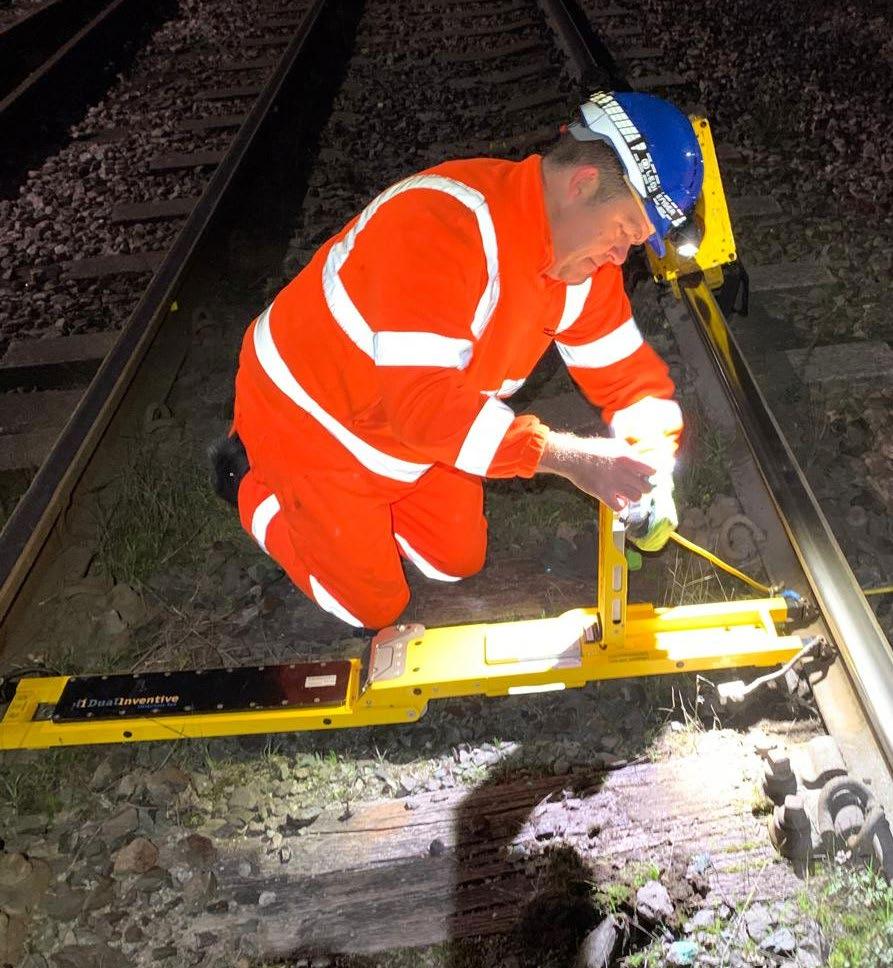
the North is now firmly in delivery mode,with significant improvements planned over the coming years.
“Initial findings indicate promising improvements in cost and time efficiencies,along with enhanced safety measures,all of which are crucial for a programme of this scale.”
Adopting the new T3-A method means:
• Fewer visits to lineside to deploy the traditional methods, only one planned visit is needed to install the ZKL 3000 RC which can stay in situ until the possession limit needs changing.
• Possession Support staff are less likely to place the protection in the wrong location or on the wrong line.
• Possession Support staff are no longer required to go on track at the beginning and end of every possession.
• Fewer telephone calls between the Person in Charge of the Possession (PICOP) and

Possession Support staff, reducing the potential for safety critical miscommunication.
• Reduced carbon footprint – by reducing travel to worksites.
By reducing boots on ballast, Network Rail is on track to create a safer, more efficient and sustainable railway for all.
The results of the trials have led to Network Rail revising the possession process by amending the Rail Safety Standards Board's industry Rule Book, enabling new safe working methods to be implemented across the UK's rail infrastructure.



Railway networks across the globe are constantly evolving to meet increasing demands for efficiency, safety and sustainability.
A key player in this transformation is Yeltech Ltd, a company renowned for its cutting-edge remote monitoring solutions. Founded in 2004, Yeltech has successfully positioned itself as an industry leader in the development of innovative technologies for the rail and asset monitoring sectors. Through the integration of Industrial Internet of Things (IIoT) and artificial intelligence (AI), Yeltech delivers real-time data insights that enhance operational efficiency and asset management.
In the railway industry, predictive maintenance and real-time monitoring have become critical components in ensuring safety and reliability. Yeltech specialises in advanced remote monitoring technologies that enable seamless and accurate data collection through both wireless and wired transmission methods. These solutions provide immediate insights that allow engineers and operators to make informed decisions, reducing risks and operational disruptions.
Yeltech’s customer-centric approach has enabled the company to forge long-term partnerships built on trust, collaboration and mutual success. By
understanding the specific needs of each industry, Yeltech tailors its solutions to ensure maximum impact and value for clients.
Among Yeltech’s suite of railway solutions, three stand out for their effectiveness:
• Rail Temperature Monitoring (RTM) Units: These devices track rail temperatures supporting railway engineers to prevent track buckling and ensuring smooth operations, particularly in regions with extreme climate variations.
• Tilt Monitoring Devices: Designed to detect structural integrity issues, these devices monitor bridge, structures and track shifts, enabling early maintenance intervention.
• Rail Pantograph Monitoring: These systems provide real-time alerts to help avoid costly breakdowns by detecting faults early, reducing unplanned maintenance and downtime.
By integrating these technologies, railway operators can minimise downtime, optimise maintenance schedules and enhance overall safety, making railway transport more resilient and reliable.

One of Yeltech’s most notable projects has been its collaboration with the Riyadh Metro, a ground-breaking public transport initiative in Saudi Arabia’s capital. Officially launched in November 2024, the Riyadh Metro spans 176 kilometres across six lines, making it

the world’s longest driverless train network. With 338 driverless train cars and 85 stations, the metro system accommodates up to 1.2 million passengers daily, with plans to expand its capacity to 3.6 million in the near future.
Recognising the need for a robust and reliable rail temperature monitoring system, representatives from Riyadh Metro maintenance team saw Yeltech’s RTM technology as an essential addition to their operations. We are grateful and proud to take a small but important part in such a great project.
Given Riyadh’s extreme temperatures, which can fluctuate significantly between day and night, rail infrastructure is particularly susceptible to track expansion and contraction. This can lead to track buckling, posing a severe risk to metro operations. Yeltech’s Rail Temperature Monitoring (RTM) units provide a reliable solution by collecting and transmitting temperature data across the metro system, allowing operators to identify potential issues before they escalate.
A key advantage of Yeltech’s RTM units is their wireless and compact design, which allows for seamless installation across multiple metro lines. The system ensures that near real-time temperature readings are accessible to engineers 24/7, helping them to
implement timely corrective measures and maintain uninterrupted metro services. By deploying these RTM units, the Riyadh Metro maintenance team has significantly improved the reliability and safety of its network, mitigating the risks associated with temperature-induced track deformations.
Yeltech’s contribution to the Riyadh Metro underscores its commitment to providing innovative technology solutions that improve urban transport infrastructure. This partnership has further solidified Yeltech’s reputation as a trusted technology provider for large-scale railway projects worldwide. The success of the RTM deployment within the Riyadh Metro network demonstrates the effectiveness of predictive monitoring in enhancing operational efficiency and safety.
Looking ahead, Yeltech is dedicated to advancing its remote monitoring technologies to support the future of railway systems globally. As smart rail solutions continue to evolve, the company remains focused on delivering high-quality, cost-effective engineering solutions that help operators maximise efficiency and minimise risks. By integrating AI-driven insights and IIoT-enabled monitoring systems, Yeltech aims to drive innovation in the railway sector and support the development of next-generation rail infrastructure.
If you’re looking to enhance safety, optimise asset performance, and reduce maintenance costs, Yeltech is ready to collaborate with you. Let’s work together to create smarter, more resilient railway infrastructure.
Contact us today to learn more about our innovative monitoring solutions and how they can benefit your operations!
For more information visit www.yeltech.com or email info@yeltech.co.uk


Magnetised rails or magnetism of ferromagnetic train components can cause significant operational challenges in the railway industry.
As a leading global specialist in demagnetisation, Maurer Magnetic provides cutting-edge solutions to the railway sector and various other industries worldwide. Whenever magnetism becomes an issue, the Swiss experts at Maurer are ready with a solution. Since pioneering a groundbreaking new demagnetisation process back in the year 2000, customised for a zero-PPM TV screen demagnetisation in a fully automated production line, Maurer Magnetic has tackled demagnetisation challenges across various
industries worldwide. Their latest innovation, the ‘Maurer PRO mobile’ demagnetisation system, enables precise and efficient demagnetisation for small or large individual components, as well as for complex assemblies, regardless of their location. With its patented technology, Maurer sets a new benchmark in industrial demagnetisation.
Residual magnetism can lead to various problems in the railway industry. Magnetised tracks or magnetism in ferromagnetic components in rail vehicles can disrupt sensor signals or the signal transmission of railway
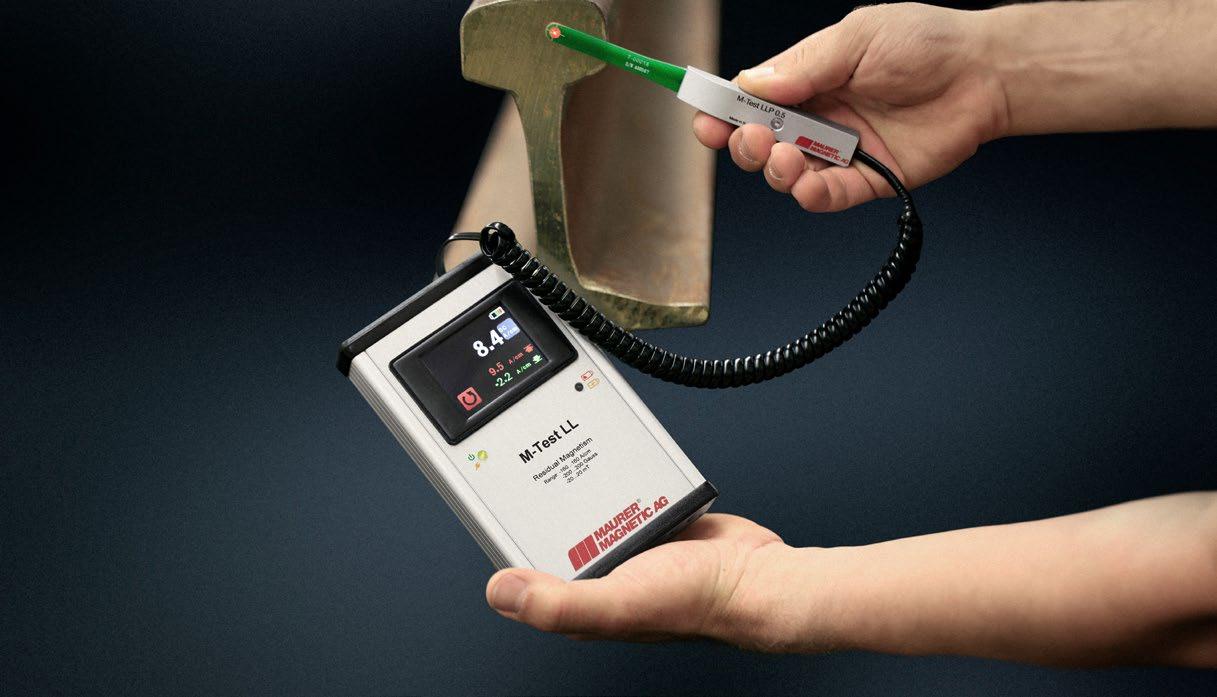
safety systems. For example, when the magnetic field generated by magnetised parts of the chassis or other ferromagnetic steel components of the train overlaps with the magnetic field of track magnets. This interference prevents the train from detecting the track magnets when passing over them. A similar issue arises when rails become magnetised, often following when doing construction work on an existing rail network. To enhance process efficiency, rails are often handled using lifting magnets, which locally magnetise the areas where these magnets were attached. Or the rails become magnetised by welding current during the installation in the track.
Additionally, some production processes for train components require powerful and precise demagnetisation. Bearings, for instance, must be demagnetised before being eddy-current tested, and train brake discs require a demagnetisation before being electron beam welded – just two examples of where effective demagnetisation is essential.
In late 2024, Maurer Magnetic introduced the new ‘Maurer PRO mobile’ demagnetisation system in three power classes: XL (70kW), L (50kW), S (30kW).
These modular and portable systems provide flexible, process-reliable demagnetisation solutions for industrial, construction, and railway applications. They enable on-site demagnetisation, regardless of component size or location. Additionally, installed components, such as rails on tracks, and assembled modules, like train bogies, can be demagnetised without removal or disassembly.
Traditional demagnetisation systems often fail to fully penetrate large or assembled components or strongly magnetised materials. The ‘Maurer PRO mobile’ system overcomes this limitation in these ways:
• It has an exceptionally strong magnetic field to remove magnetism also from strongly magnetised parts and adjustable frequency to enable deep penetration into the material
• Its adaptable, flexible cable coils can be adjusted to complex geometries and large surfaces to ensure that the magnetic field of the demagnetiser is applied in the best possible way to the magnetised area of the parts
• Its modular, air-freight-compatible trolley system simplifies logistics and on-site handling
For inline serial production, stationary demagnetisation systems remain the preferred solution. Maurer Magnetic offers a wide range of stationary systems, from compact standard units to large, customised highperformance demagnetisers.
However, for rail tracks or installed components in the train, mobile demagnetisation solutions are the only practical option. The Maurer PRO mobile system provides an optimal solution for:
• Demagnetisation of installed vehicle components or large assemblies
• Removing localised magnetisation on rails
• Long railway track demagnetisation
For frequent on-site applications, investing in a Maurer PRO mobile machine and building in-house expertise is recommended. For one-off requirements, rental units are available, along with Maurer Magnetic’s expert demagnetisation services worldwide.
www.maurermagnetic.com


Magnetism in rails causes:
problems to detect track magnets
malfunction of the train control system
Maurer Magnetic supplies solutions to demagnetize local magnetism in tracks or for larger track networks

The flexible ARCOSYSTEM® troughing can be easily adjusted for height and directional changes during a long run

The lightweight construction of the troughing allows ARCOSYSTEM® to be fitted to hillside slopes

The composite troughing can be fastened to a variety of trackside structures, such as ballast boards and railings here during an installation in Germany’s Black Forest

The twin-walled design of the troughing enables the system to resist lateral forces such as wind effects from high-speed trains
UK distributor: Complete Composite Systems Ltd
85 Great Portland Street, London, W1W 7LT
T: +44 1462 379000
E: info@completecomposites.co.uk
W: www.completecomposites.co.uk



UK stockist: Scott Parnell Rail Division, Asheton Farm Business Centre, Stapleford Abbotts, RM4 1JU
T: +44 208 8055797
E: rail@scottparnell com
W: www scottparnell com/rail



ARCOSYSTEM® – the rail industry’s leading elevated cable containment system – has reinforced its reputation for sustainability by gaining major environmental certification.
Complete Composite Systems (CCS) is delighted to announce that ARCOSYSTEM® has officially achieved Environmental Product Declaration (EPD) verification. An EPD is a formal document that demonstrates a firm commitment to environmental responsibility and transparency. It is based on a detailed and independently verified life cycle assessment (LCA)
that determines the environmental impact, such as of greenhouse gas emissions, of a certain product throughout its entire lifespan.
There were two LCAs conducted for ARCOSYSTEM®; one relating to the installation of the system via ground-mounted sigma posts, and the other based on attaching the flexible ARCO cable troughing to bridges and walls.
These LCAs were conducted under what is specified as a ‘cradle to gate with options’ boundary. This covers the extraction/cultivation of raw materials, the processing of raw materials, the production of the finished product

(including packaging), all transportation and waste stages throughout the supply chain, and the end-of-life of the product.
This robust study was conducted in line with ISO 14040/44, ISO 14025 and EN 15804 by the independent consultancy Fishwick Environmental Ltd. It was then critically reviewed by an accredited independent verifier, and published by the International EDP System, the world’s first and longest-running
operational EPD programme, founded in Sweden in 1998.
This important milestone is not just a stamp of approval – the certification serves as a quantitative environmental profile of ARCOSYSTEM®’s creation, manufacturing, distribution and end-of-life. The productspecific results allow contractors, specifiers, engineers, clients and other stakeholders to view impartial evidence of the environmental profile of ARCO, and invites comparisons with similar products that also have a published EPD.
Achieving EPD verification also makes CCS’s decarbonisation measures for ARCOSYSTEM® transparent to prospective customers who are focused on sustainability and want to work with companies who take their environmental responsibilities seriously.
It provides further confidence that ARCOSYSTEM® is designed with environmental impact in mind, while maintaining the highest levels of efficiency and longterm durability. It also illustrates that ARCOSYSTEM® is not just the most innovative solution for elevated cable containment on the market, but also one of the most sustainable.

• An elevated cable management system that safely encloses and protects high-voltage and digital communication cables for long runs alongside railway tracks
• Troughing and lids are manufactured from pultruded glass fibre-reinforced polymers (FRP/GRP) which excel in structural and load-bearing performance and offer strong resistance to heat, water, corrosion and UV rays compared to more common materials, thereby providing a long lifespan and sustainability
• Composite construction means the troughing is lightweight, allowing for flexibility when installing along a challenging trackside route as height and directional changes can be accommodated with ease
• Supported by a bespoke range of laser-cut galvanised steel brackets, the troughing can be post-mounted, wallhung or fixed to a variety of trackside structures such as bridges, railings, rock faces, noise barriers or hillside slopes
• Troughing can span up to 6m between support posts, making installation quicker and more cost-effective than traditional ground-based systems
• Twin-walled design of the troughing enables the system to resist lateral forces from embankment subsidence, high snow loads and wind effects from high-speed trains
• Constant working temperature range from -40˚C to +80˚C
• Carries cable loads of up to 90kg/m
• Troughing available in different cell sizes to accommodate a range of cable load requirements or spatial restrictions
The sigma post-mounted EPD for ARCOSYSTEM® can be viewed here, and the bridges and wall-mounted version is available here
CCS has previously released EPDs for two of its other products, TouchSAFE composite palisade fencing and our composite ballast boards.

ARCOSYSTEM® safely attached to a slanting concrete wall with the aid of the system’s supporting range of bespoke steel bracketry
Contact the experienced technical experts at Complete Composite Systems, the exclusive UK distributor of ARCOSYSTEM®, for enquiries about your rail cable containment requirements.
Complete Composite Systems Ltd

85 Great Portland Street, London, W1W 7LT
Tel: +44 1462 379000 or +44 7860 147863
Email: info@completecomposites.co.uk
The exclusive UK rail stockist of ARCOSYSTEM® is Scott Parnell:

Scott Parnell Rail Division
Asheton Farm Business Centre, Stapleford Abbotts, RM4 1JU
Tel: +44 208 8055797
Email: rail@scottparnell.com
ARCOSYSTEM® is manufactured by CCS’s Swiss partners, Castioni Kabelführungssysteme GmbH

The rail industry is evolving, and staying ahead means upgrading ageing networks while keeping sustainability, safety, and efficiency in mind. TXO helps rail operators meet these demands by recovering valuable assets, modernising networks, and reducing environmental impactall while saving costs.

How we’re making a difference
› SWB Bus und Bahn: Urban mining in action
We helped SWB Bus und Rail, the metro and urban rail operator for the city of Bonn, Germany, recover 150 tonnes of copper from 280 tonnes of disused signalling cables across nearly 16 km of track.
This urban mining project reduced fire hazards, freed up space for future infrastructure, and supported circular economy goals. By transforming obsolete infrastructure into a valuable resource, SWB made a profit while cutting CO2 emissions by 237 tonnes.
› Network Rail: Repairing legacy telecoms
For over 15 years, we’ve been Network Rail’s trusted repair partner, extending the life of telecom equipment over 30 years old. In the past year alone, we repaired over 100 legacy units, with just 7% found beyond economic repair.
Our work supports critical signalling systems, avoids the need for retraining staff on new telecom platforms, and reduces environmental impact - all while maintaining the highest standards of safety, quality and performance.
Transforming technology for a sustainable future
Decommissioned cables and ageing equipment is a hidden revenue stream. We specialise in urban mining, extracting valuable materials like copper from old networks and sourcing rare or end-of-life components to keep systems running.
Extend equipment life with expert repair
We’ve helped major operators like Network Rail avoid costly replacements by repairing, upgrading and enhancing equipment that’s decades old.
Upgrading railway systems can be complex and expensive. We make modernisation seamless by efficiently removing outdated technology, freeing up space, and ensuring a smooth transition to newer systems.
We recycle approximately 100 tonnes of material each month, helping rail operators meet sustainability targets with identifying and salvaging their forgotten assets out of their urban mine.

Transforming technology for a sustainable future
Don’t




Harsco Rail, a global leader in innovative track maintenance and construction solutions, proudly announces the successful completion of a track improvement project in partnership with Trojan Rail earlier this year.
A valued customer approached Harsco Rail to provide a solution for dipped rail welds on their network, impacting their operation through track degradation and potential damage to rollingstock. Harsco Rail provided 'Rastic' contracted services, a solution/
methodology that has been in practice for close to 20 years. This ambitious endeavor demonstrated exemplary teamwork, precision and commitment to quality by addressing dipped rail faults across 700 kilometres under some of Australia's most challenging conditions – all while upholding an impeccable safety record.
Harsco Rail worked closely with Trojan Rail to deliver this project. On-site labour resources, provided by Trojan Rail, ranged from 6 to 11 crew members at
various stages of the project. Every team member played a crucial role in its success, combining expertise and dedication to meet the highest standards.
The collaborative spirit extended to the client, whose unwavering support throughout the project underscored the shared commitment to achieving exceptional results.
The methodology utilised during this project was robust and innovative, marking another milestone in Harsco Rail's track improvement capabilities. Key steps included:
• Pre-Measurement: Manual measurements to identify peaks and dips at CWR joints, with markings and notes for variations
• Equipment Utilisation: Deployment of two Rastic trucks and a hy-rail excavator equipped with a tamping head
• Peak Correction: Adjustments using Rastic equipment to achieve 0.3–0.5mm peaks, verified on-site final grinding completed by customer
• Track Consolidation: Excavator tamping three sleepers on either side of corrected dips to stabilise the track
• Rail Breakage Management: Immediate rectification of rare rail breakages (<0.5% of corrections) by skilled rail welders
This methodology has proven effective and reliable, yielding outstanding results and minimal disruptions.
Building on the success of this project, Harsco Rail is excited to introduce the second-generation Rastic—a concept set to revolutionize track improvement services with cutting-edge innovations. Highlights include:
• Automated Efficiency: Automating track geometry measurements, including peak and dip detection, for enhanced productivity and accuracy
• Improved Safety: Enhanced people/plant separation and upgraded designs for lower centres of gravity (COG) and vehicle stability

• Expanded Coverage: Ability to bend 68kg rails, covering Australia’s standard gauge network comprehensively
• Upgraded Systems: Advanced bending algorithms, touchscreen controls and better diagnostics to reduce downtime and boost productivity
• Crew Optimisation: Reduced on-site crew sizes due to automation, lowering operational costs
• Regulatory Compliance: RISSB-compliant upgrades hy-rail vehicles
• Smart Reporting: Automated production reports for seamless progress tracking
The second-generation Rastic redefines track maintenance by offering customers a cost-effective, safer, and more efficient solution for their network's dipped rail corrections.
The accomplishments of the Harsco Rail team, Trojan Rail and our dedicated client highlight the power of collaboration and innovation. As we move forward, Harsco Rail remains steadfast in its commitment to quality, safety and continuous improvement – ensuring every project meets and exceeds expectations.
www.harscorail.com

If you're in the market for rail maintenance equipment but don't want to break the bank, you're in luck! We offer a wide selection of high-quality used machines at affordable prices.



Our used machines are carefully inspected and refurbished to ensure they are in top working condition. We have a variety of equipment available, including:
Tampers
Rail grinders
Ballast regulators
Track renewal trains
And more!
Don't wait to take advantage of our great deals on used rail maintenance equipment! Contact us today to learn more and find the perfect equipment for your needs.
No matter what type of equipment you need, we have options available to suit your needs and budget. Plus, with our experienced team of technicians, you can rest assured that your equipment will be well-maintained and ready to perform when you need it. Scan




ZAUGG AG EGGIWIL - Innovation, Precision and a
For decades, ZAUGG AG EGGIWIL has stood for the highest quality, pioneering innovation and unwavering passion in the development of professional snow clearing technology.
What once began with agricultural machinery has developed into a globally recognised company that sets standards in snow clearing.
With our relentless pioneering spirit and deep-rooted expertise, we have revolutionised snow clearing technology, particularly in the rail-mounted sector, over the last few decades. Initially greeted with scepticism, two-stage technology has now proven to be an economical and efficient solution – a success that we have achieved thanks to our decades of experience, technical perfectionism and tireless passion.
Our projects speak for themselves:
• The Rhaetian Railway’s four rammed snow ploughs, which keep the tracks clear on the high-alpine Bernina and Albula lines
• The Jungfrau Railway’s self-propelled snow plough, which works reliably even in the most extreme conditions
• Our masterpiece in Sweden, which defies snow and ice on the iron ore line between Kiruna and the Norwegian border
• The wedge snowploughs of the Matterhorn Gotthard Railway, which ensure smooth connections in alpine regions
These successes are no coincidence – they are the result of our deep conviction that technical perfection
can only be achieved through experience, innovation and the courage to break new ground. We continue to expand in this area and are delighted that our expertise is recognised worldwide.
But we go even further: in addition to our flexible snow blower technology – regardless of the energy source – we also develop customised auxiliary equipment for extreme applications. Temperatures well below freezing? Clearing snow in the middle of the night? No problem for us. At the same time, we place great emphasis on operator comfort, because only someone who feels comfortable in his machine can control it with maximum precision.
With a strong focus on engineering, we offer not only world-class products, but also tailor-made solutions for railway operators worldwide. Because true innovation is created where expertise, passion and cooperation come together.

ZAUGG AG EGGIWIL – because snow clearing is more than just technology. It is passion in motion.
www.zaugg.swiss

Individual custom-made and customerspecific solutions for all rail-related needs. We are your trusted partner in system engineering, manufacturing, maintenance, and modernization of both attachments and complete rail vehicles.


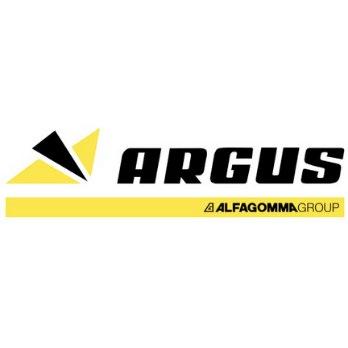
The Double Dam features a single internal stabilizing panel to provide safety and stability for all sizes up to 4' (1.2m) high.
Double Dams are reusable, repairable, provide flexible layout options, do no substrate damage, and are suitable for worksite dewatering and flood protection in waters up to 3' (0.9m) deep.





The global leader in rail infrastructure technology for 70 years, we’ve created infrastructure in over 100 countries. That means we’ve experienced just about every situation, problem, question and solution before. We share our global knowledge with your business so you can reach your objectives quickly and efficiently.

Customer: Alstom, as contracted by the Municipality of Florence
Construction Start Date: 2015
Sector: Light Rail
Track length: 18,000 lmst
Customer Challenge:
Florence in Italy, the symbol of the Renaissance, and a UNESCO World Heritage site. Since the city’s tram came into operation, locals and tourists alike have been able to make use of this quiet and clean mode of transport.
For the installation of Lines 2 and 3 of Florence’s tramway, track vibration was a serious concern. The track passes just a few metres away from beautiful
the concern that the tramway would generate noise that could be heard in the churches nearby, disrupting these sacred spaces. Secondly, was the need to protect the fragile buildings from any cracks caused by vibrations. In light of the above, the noise & vibration attenuation required was 20dBv – an extremely demanding rate.
One other challenge of this project was the presence of historical ruins below the track. With the city having been built in Roman times, there are many architectural artefacts beneath the modern city. This dictated the excavation depths when carrying out civil works. Furthermore, installation needed to be quick and efficient due to the tramway’s placement in a central area so construction time needed to be kept to a minimum.
Finally, stray current protection was one other element


Pandrol was selected as we provided a solution that could solve all of the project’s challenges. Rather than needing to go to multiple different companies, the customer could benefit from our solutions in noise & vibration as well as stray current protection.
The customer could also benefit from tried and tested solutions, both proven in past projects such as Athens, but also demonstrated in modelling through our innovative Track Elastic Model (TEM) software which we developed to simulate the conditions and monitor the effectiveness of our solutions. Through relying on Pandrol’s knowledge, experience and theoretical modelling, it was clear we were experts who could rise to the challenge – not only through the supply of worldleading products, but also through our engineering knowledge on noise & vibration.
We proposed using our Floating Slab Mat (FSM) in combination with our fully embedded rail system, Pandrol QTrack®. Our floating mat is designed to give dependable performance in noise & vibration reduction. By building the track on the mat of encased resin-bonded rubbers, this isolates the vibration by keeping it within the system. Both systems together allowed for decreased depths of the excavation whilst still keeping high vibration attenuation.
Pandrol QTrack® provides vertical and lateral support to the rail, reducing vibration transmission from the rolling stock to the surrounding structures, and granting control of the electrical flow out of the rails (stray currents). As it is a continuously supported system, fully bespoke for each project, the elastic rubber profiles decrease the phenomenon of
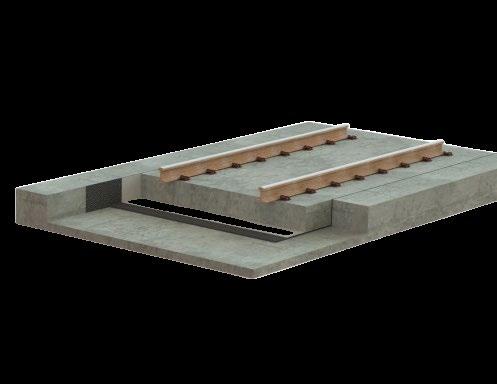
corrugation or surface waves that cause vibration. All of this results in less vibration, less noise and fewer cracks.
To tackle the project’s demanding tight construction deadlines, our system’s prefabricated concrete beams or slabs suited the need for quick installation and minimum traffic disruption. With this type of installation, we weren’t restricted by climate or weather that could have disrupted the progress, and could be more efficient by having work done in parallel.
After the installation of Lines 2 and 3 were finished, we were pleased to see excellent results from third-party measurements and monitoring. The calculations we had estimated from our TEM modelling were accurate and we received certification to confirm that the systems showed complete compliance and satisfaction in terms of rail stability, electrical insulation and noise & vibration levels with zero structural damage along the whole track length.
In 2023, we were awarded the new phase based on the excellent performance of our system.
www.pandrol.com



J. LANFRANCO & Cie p.88
Argus Fluidhandling p.90
BITZER Kühlmaschinenbau GmbH p.92
Traction & Power Supplies
FLENDER p.94
Capitol Industrial Batteries p.97
Rolling Stock Manufacturing & Maintenance
Evident p.98
Totalkare Ltd p.101
Design
netwiss p.104
Testing & Measuring Equipment
HEXAGON p.107

J. LANFRANCO
In many industrial sectors, the use of composite materials and thin sheet metal represents a challenge when it comes to fastening.
These materials, which often do not have the thickness required for threading, are not able to easily support traditional fasteners or inserts.
This is a common problem for manufacturers, equipment suppliers and maintenance workshops, especially in industries where high-strength, lightweight materials such as composites are increasingly used.
The problem is highlighted when composite panels are attached to metal structures, requiring secure solutions.
J. LANFRANCO & Cie has designed a range of innovative fastener solutions specifically to meet the challenges faced in industries using composites and thin metals.
By developing modular fixtures with unidirectional and multidirectional movement capabilities, the company offers a highly efficient and cost-effective alternative to traditional methods. These solutions remove the need for costly processes such as laser cutting or complex machining, while providing precision fastening with tolerances as tight as 0.5mm. This not only ensures precision, but also significantly reduces overall manufacturing costs.
The main innovation lies in the polyvalence of the profiles.
Manufactured from a choice of materials, including stainless steel, aluminium and steel, and designed with our self-locking nuts with double superposed slots, these profiles are available in two configurations:
• unidirectional movement, which offers a predefined range of movement
• multidirectional movement, which allows flexibility on a given surface

For applications requiring complex assemblies, such as in the rail, these profiles are ideal for securely fastening composite panels without compromising the structural integrity or precision of the assembly.
J. LANFRANCO multi-directional modular fixtures allow 12mm movement in all directions. These fasteners adapt to imperfections in the assembly, minimising costly interventions and improving installation and maintenance times.
The use of these systems is particularly advantageous in industries where labour costs are high, as the fasteners can be installed quickly and efficiently using simple riveting techniques, without the need for welding or other labour.
These products can be adapted for each application to meet the specific needs of our customers.
In conclusion, J. LANFRANCO & Cie's innovative fastening solutions represent a major step forward for industries working with thin materials and composites, offering reliable, adaptable and cost-effective solutions.

For more information visit our website www.lanfranco.fr/en or email commercial@lanfranco.fr

Alfagomma 2SC and 2TE are now compliant with the EN 45545-2 standard, requirements for fire behaviour of materials and components in the railway industry. Railway hoses 2SC and 2TE are tested to guarantee the highest levels of safety and performance. The new standard EN 45545-2 is replacing the following country standards.



Exceeds EN
Tube: Oil resistant
Reinforcement:
Cover: Abrasion, Application:
Specially designed
Constant Operation:
Length: Random
ISO 18752 - Exceeds SAE 100 R15 EN 45545-2 - R22
Tube: Petroleum and biodegradable hydraulic fluid resistant
Reinforcement: Four/six high tensile steel spirals.
Cover: Smooth up to 1”, wrapped over 1”. Abrasion,
Application: Very high pressure hydraulic lines, fuel,
Specially designed for long service life in very demanding pulsating pressure and tight bend radius are required
Constant Operation: -40 °C +120 °C (-40 °F +250 °F)
Length: Random up to 1” - 61 m max over 1 1/4”


ISO 11237 - EN 857 2SC - EN 45545-2 R22 (HL1-HL2) - R23 (HL1-HL2-HL3)
Tube: Oil resistant synthetic rubber
Reinforcement: Two high-tensile steel braids
Cover: Abrasion, ozone and hydrocarbon resistant synthetic rubber
Application: High pressure hydraulic lines, fuel oil, antifreeze solutions, air and water
Especially designed for railway applications
Constant Operation: -40 °C +100 °C (-40 °F +212 °F) air max T = +70 °C (+160 °F)
Length: Random
EN 854 2TE - EN 45545-2 R22 (HL1-HL2) - R23 (HL1-HL2)
resistant synthetic rubber
Reinforcement: one high tensile textile braid.
Abrasion, ozone and hydrocarbon resistant synthetic rubber.
Application: Medium pressure hydraulic lines, fuel oil, antifreeze solutions, air and water. designed for railway applications.
Operation: -40 °C +100 °C (-40 °F +212 °F) air max T = +70 °C (+160 °F) Random R22 (HL1) - R23 (HL1-HL2)
resistant synthetic rubber
ozone and hydrocarbon resistant synthetic rubber oil, lubricants, antifreeze solution, air and water demanding applications where compact design, high required °F)



The phase-down of fluorinated refrigerants is accelerating in the EU. Due to current regulations, natural refrigerants are in growing demand for mobile applications, such as heating and air conditioning in rail vehicles.
BITZER offers reciprocating and scroll compressors designed for operation with natural refrigerants, optimally tailored to the needs of railway heating and air conditioning systems.
The refrigeration, air conditioning and heat pump industry supplying to Europe must already prepare for severe refrigerant restrictions on new and existing systems. Above all, the F-Gas Regulation 2024/573 requirements are decisive, combined with the expected PFAS bans under the EU REACH chemicals regulation. Natural refrigerants are gaining importance as they are
considered to be available in the long term due to their low environmental impact.
To secure investments, it is crucial to reconsider the heating and cooling systems of rail vehicles due to their long development and service lifespans. Natural refrigerant solutions should match or exceed the energy efficiency of conventional systems while maintaining or reducing equipment, operating and maintenance costs. Components must meet strict requirements, as reliability, efficiency and durability directly affect overall costs.
The hydrocarbon refrigerant propane (R290) is an attractive option due to its excellent thermodynamic properties. BITZER has many years of experience in the

field of natural refrigerants, offering a comprehensive portfolio of suitable components. For propane, these include the ultra-compact, low-noise scroll compressor series SPEEDLITE ELV52 PRO, which is around 50 percent lighter than conventional models. The compressors feature a highly efficient suction gascooled permanent magnet motor and an outstanding cooling capacity to weight ratio. The wide control range ensures efficiency even under dramatically changing conditions, while a separate speed control adjusts capacity to the current cooling and heating load, ensuring high passenger comfort at all times.
In order to reduce operating costs and minimise the carbon footprint through lower energy consumption, the reciprocating compressor technology for the transport sector, the BITZER ECOLINE PRO series, has been developed with a particular focus on energy efficiency. Mechanical capacity regulators enable virtually stepless capacity control, ensuring unmatched efficiency during part load operation throughout the year.
CO2 (R744) represents another environmentally friendly alternative for the air conditioning of rail vehicles. In this case, it is also important that the systems are


designed to be as lightweight as possible in order to minimise the roof load and reduce power consumption during operation.
The CO2LITE reciprocating compressors from BITZER are an ideal option. With a low height of 257mm and a weight of less than 80kg, the CO2LITE meets the highest efficiency requirements even at low ambient temperatures. The reciprocating compressors have a wide capacity range and are particularly strong in complete thermal management, enabling environmentally friendly CO2 systems even in the smallest of spaces. Another advantage for systems engineering: the CO2LITE can be used both horizontally and rotated 90° around its longitudinal axis, thus offering maximum flexibility.
As an independent specialist for refrigeration, air conditioning and heat pump technology, BITZER is present all over the world: with products and services for refrigeration, air conditioning and process cooling as well as transport, BITZER ensures optimum temperature conditions for trade in goods, industry processes and indoor climate control – always striving for the highest possible energy efficiency and quality.
BITZER is represented all over the world with 75 sites in 40 countries, including its sales companies and production facilities. Trade and service partners included, the BITZER network of manufacturing, development and sales extends to almost all countries in the world. In 2023, more than 4,300 employees generated a turnover of €1.01 billion; expenditure for research and development totalled €61 million.


The next generation of high-speed trains is facing a unique challenge: How can vibrations caused using locomotive drives be efficiently prevented? Unlike the decentralised single-vehicle drives used in high-speed trains of the past, modern high-speed trains are once again relying on stronger and larger locomotive drives. This design inevitably leads to a greater unsuspended mass on the tracks. The result is significant vehicle vibrations due to track irregularities, especially at high speeds. These vibrations are directly transmitted to the gearbox, motor and vehicle frame, which must be avoided.
The problems caused by vibrations and shocks are manifold and have far-reaching consequences for the operation of high-speed trains. First, they lead to increased susceptibility to faults and wear, as well as material stress on the drive and vehicle. This shortens maintenance intervals and reduces the lifespan of critical components, significantly increasing long-term operating costs.
Vibrations and shocks also affect ride comfort. Passengers and railway staff perceive these vibrations as disturbing. The ride becomes noisier and less

pleasant, affecting activities such as sleeping, reading and overall comfort in the vehicle. For high-speed trains known for their smooth and comfortable rides, these negative side effects can impact passenger numbers and have long-term economic consequences.
Moreover, the environment is affected. As speed increases, the train emits noise and transmits noticeable vibrations to the surroundings, such as when passing through stations or residential areas.
As the first coupling manufacturer, Flender has developed an innovative solution for this complex challenge: the fully-suspended locomotive drive coupling ZBG 450. This novel coupling is specifically designed to address the described problems and enhance the ride quality and comfort of high-speed trains.
The ZBG 450 coupling replaces the conventional double-cardanic, elastic couplings typically used in locomotive drives and features a unique concept. Unlike other couplings, it is a gear coupling that is significantly smaller than usual locomotive couplings because it no longer encircles the entire axle. While the axle still passes through the coupling, Flender has completely rethought the concept and reversed the interface to the coupling. The coupling is mounted on the side of the gearbox facing the axle connection. Conventional drives require a much larger and heavier coupling solution that must be guided through the gearbox's hollow shaft. This design change reduces

the weight by several hundred kilograms. Thus, it is a very cost-effective and lightweight coupling design that significantly improves drives for fully-suspended locomotives.
The ZBG 450 coupling was first presented to the public at InnoTrans 2024 and garnered great interest. It is a clear testament to Flender's innovative strength and application and manufacturing expertise. With this solution, Flender offers its customers not only an effective way to tackle the vibration challenges of modern high-speed trains but also the assurance that they can rely on technologically advanced and reliable products.
Thanks to Flender’s fully-suspended locomotive drive coupling ZBG 450, major vibrations in nextgeneration high-speed trains are a thing of the past. This innovative solution allows the benefits of powerful locomotive drives to be used without the associated drawbacks of vibrations and shocks. The ZBG 450 coupling significantly reduces the susceptibility to faults and wear, as well as the material stress on the drive and vehicle, positively impacting the lifecycle of the drive. Simultaneously, it greatly enhances ride comfort, benefiting both passenger and crew satisfaction, and the environment by reducing vibrations and noise emissions.
Flender has successfully addressed a major challenge with the development of the ZBG 450. As the first provider on the market, Flender has developed a coupling solution that meets the specific requirements of modern high-speed trains while maintaining the highest standards of reliability and durability.
The positive response from the market at InnoTrans 2024 underscores the company's innovative strength. With the ZBG 450 coupling, Flender is setting new standards in the railway industry and offering a forward-looking solution that both reduces operating costs and extends the lifespan of vehicles. Flender's customers can rely on this coupling technology to be well-equipped to successfully meet the challenges of modern long-distance travel.

HIGH SPEED WITHOUT VIBRATIONS.


Solved. The ZBG 450 fully suspended locomotive drive coupling.

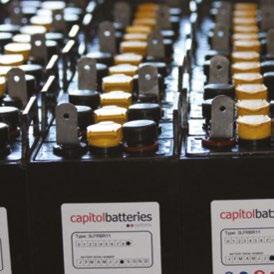








Whether you require batteries repaired, overhauled or replaced, Capitol are trusted and relied upon by a wide range of UK rail industry companies, who have come to know that we deliver on our promises to provide exacting standards of product, service, ongoing technical support and commitment in all aspects of our business dealings
An independent manufacturer with enough strength and flexibility to be able to support mainline customers requirements through stock availability and technical experience, we have consistently delivered on a wide variety of projects ranging from single battery orders, to fleet change out programmes set against customer schedules and agreed service levels


Rail axles are among the most highly stressed components in railway vehicles, engineered to withstand millions of load cycles under extreme forces.
Despite precision manufacturing processes, imperfections can still occur from forging, machining and heat treatment, making rigorous inspections essential before axles enter service.
Historically, magnetic particle inspection (MPI) has been the primary method for detecting surface-breaking flaws. However, its reliance on subjective interpretation, lack of measurable and storable data, and extensive processing time present significant drawbacks. MPI is a hit-or-miss method, meaning defects are either detected or missed, with no precise flaw depth sizing or digital records. This makes it difficult to assess defect severity or ensure long-term traceability.
As axle quality standards evolve, eddy current array (ECA) technology is emerging as a valuable alternative. By providing real-time digital imaging, automated defect sizing and faster, more repeatable inspections, ECA technology eliminates many of MPI’s inefficiencies while substantially improving flaw detection confidence and operational efficiency.
Although eddy current testing (ECT) is no new technology – having long been used to detect surface and near-surface flaws in conductive materials –traditional single-coil eddy current probes bring

inherent limitations in coverage and resolution. The development of eddy current array (ECA) technology however, has significantly enhanced the capabilities of ECT, unlocking new potential for flaw detection applications, including rail axle inspections.
ECA technology leverages multiplexed eddy current coils arranged in a probe, increasing coverage, channel resolution and coil sensitivity, allowing for:
• Wider coverage in a single scan, reducing inspection time
• Improved flaw detection through optimised coil configurations
• High-resolution imaging, providing detailed defect characterisation
• Digital data collection, enabling full traceability for compliance and quality assurance Directory Rolling Stock
These capabilities make ECA an ideal solution for post-manufacturing axle inspections, allowing manufacturers to systematically assess critical stress locations, including wheel seats, dust guards and transition radii, before axles enter service.
Recognising the value of ECA technology, and the need for optimised solutions tailored to complex axle geometries, Evident Scientific has expanded its eddy current technology capabilities by developing customengineered ECA probes and specialised probe holders tailored to rail axle inspections. These solutions address the unique challenges of inspecting both flat axle sections and transition radii, which are critical stress zones where defects are most likely to develop.
The flat section ECA probe is specifically designed to scan the top generatrix of the axle, covering critical areas such as wheel seats, journal surfaces, dust guard regions and the axle body. To ensure precise and stable positioning, a custom probe holder was also developed to maintain consistent contact with the axle surface, adapt to different axle diameters and ensure seamless transitions between sections. This alignment enhances scanning accuracy and improves defect detection.

The transition radii ECA probe overcomes the limitations of conventional testing methods, which often struggle to detect flaws in axle fillets and curved sections due to inconsistent probe contact and signal variations. Featuring a circular multi-coil array with a 25mm radius, this probe can scan transition radii of ≥25mm without the need for repositioning.
The flexible sensor design ensures uniform sensitivity across curved surfaces, eliminating signal dropouts that rigid probes typically experience. Additionally, a rotating housing enables smooth, controlled scanning along transition fillets, maintaining consistent contact and significantly improving flaw detection accuracy.
These custom-engineered ECA probes and holders, when paired with an advanced ECA testing platform like the Evident QuickScan iX ECA, enable advanced signal processing and high-speed data acquisition, delivering exceptional performance in rail axle flaw detection.
The advancement of ECA technology presents a significant opportunity to elevate rail axle inspection standards. Providing greater coverage, higher resolution, data storage and quantifiable defect data, ECA enables high-speed, robust evaluations, offering a more efficient and reliable alternative to conventional MPI methods.
Raising the bar in axle inspections, Evident is helping the rail industry leverage the potential of ECA technology, with specialised ECA probes and holders tailored for axle geometries. As axle manufacturing evolves, so must inspection technologies. By embracing ECA, the rail industry can improve quality control, reduce inspection times and enhance the long-term reliability of its rolling stock.
Want to find out more?
Contact our expert team today.


The New OmniScan™ X4 Flaw Detector
Engineered for Speed & Simplicity
Advanced imaging technology and an easy-to-use interface allow users of all skill levels to perform fast, accurate inspections—boosting performance and streamlining workflows.
Proven to Perform, Trusted to Deliver
An all-in-one imaging platform, coupled with unmatched portability and versatility, delivers exceptional results in even the most challenging inspection environments.
Designed to Evolve with Your Needs
With free quarterly software updates, the OmniScan X4 empowers you to continuously adapt to future inspection needs—ensuring that you’re always ready for what’s next.


Reliable lifting and testing equipment for all rail vehicle maintenance.
Totalkare combines world class products with industry leading support to facilitate effective maintenance and repair.
MOBILE RAIL LIFTING JACKS
HEAVY DUTY RELIABLE SYNCHRONISED
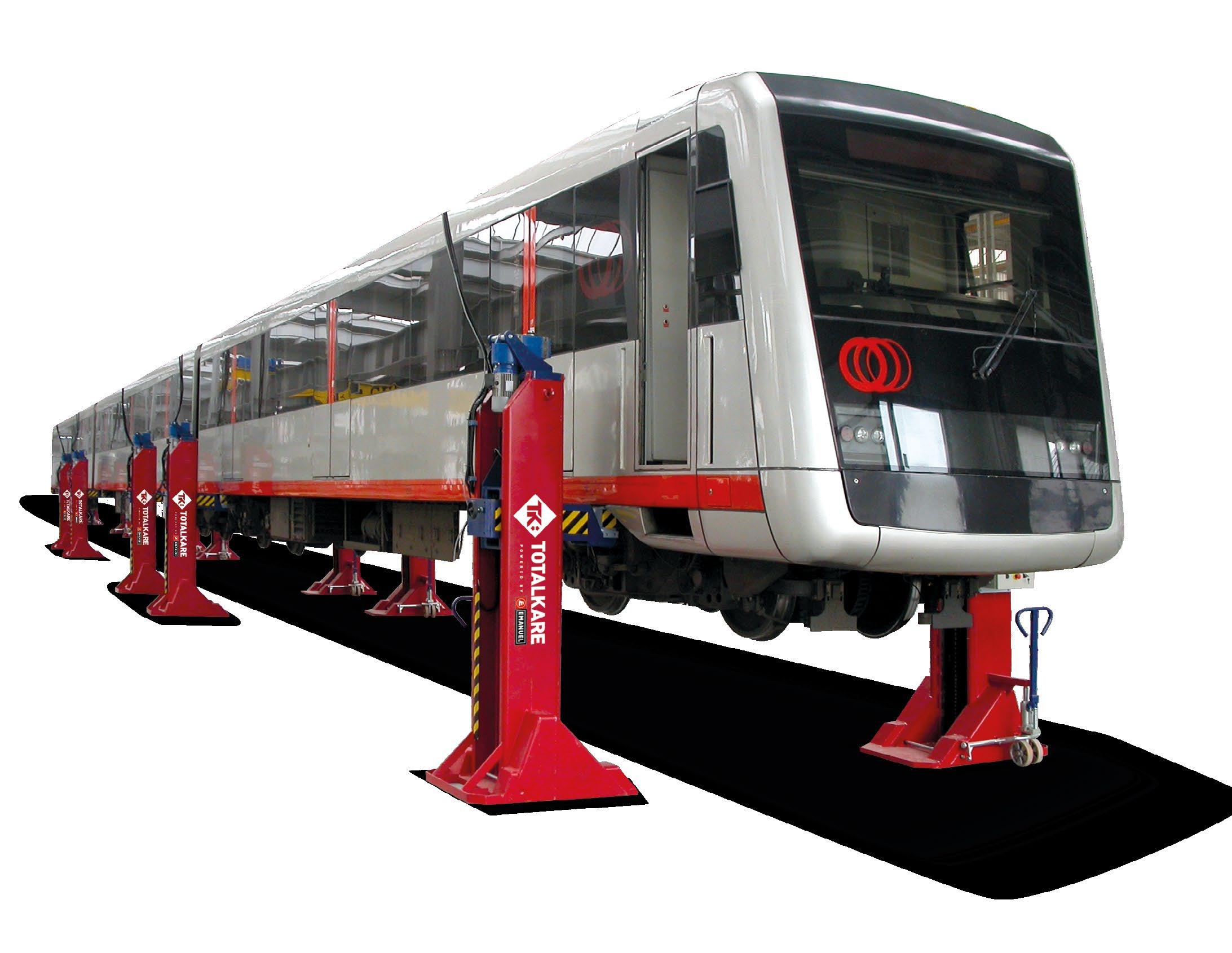

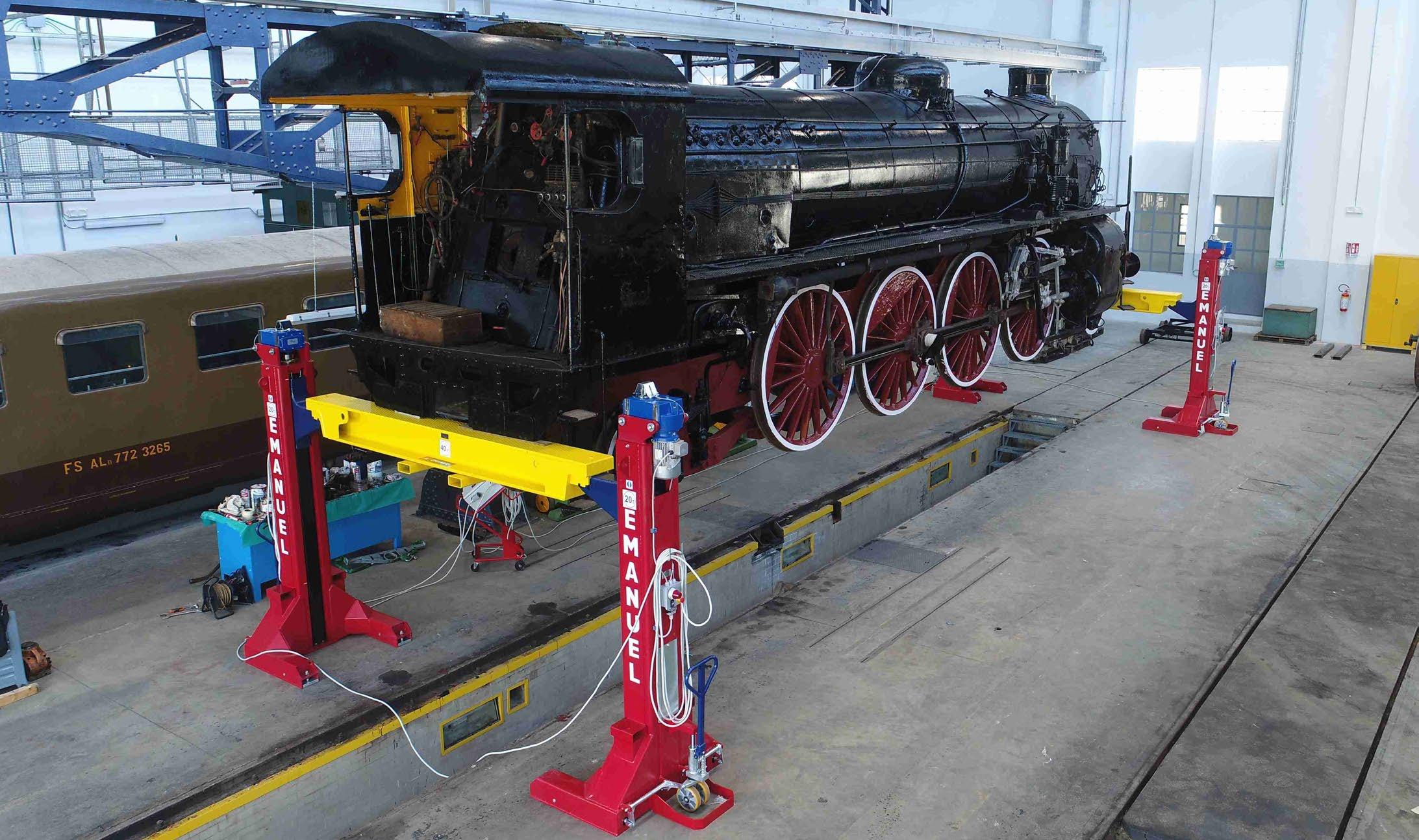
Working with heavy-duty vehicles comes with its own challenges. But when you’re working in rail, everything is amplified:
The weight, the size – and the consequences of any hazards.
So if you’re running a rail depot that needs to lift rolling stock, you need the strongest and safest rail lifting equipment around.
Here’s what you need to get started:
Compared to some parts of the train, a railway bogie can be one of the most complex and componentdense parts of a rail system.
Between the wheels and axles and suspension, there’s a lot going on – and that means it’s one of the most commonly serviced and maintained parts of a train.

That’s why lots of rail depots invest in specialised equipment designed specifically for working on bogies – like our Totalkare Bogie Lifting Platform
It’s a self-contained mobile unit that runs on rails with a battery-driven motor controlled by a wireless remote, sliding underneath a railway bogie and raising it up on an electrohydraulic lifting system.
With the bogie safely raised above the tracks, your teams can get the access they need to the critical components and systems that need servicing – before safely lowering the bogie back into operation on the tracks.
So how much can it lift?
Our railways bogies come with lifting capacities between 6,000kg and 14,000kg – which means they’re a perfect fit for lifting almost any single railway bogie you’re likely to see in your depot.
If you’ve seen our industry-leading mobile column lifts, you’ll know exactly how our Railway Lifting Jacks work.
Each mobile column gets wheeled into position and attaches to the train carriage to form a set of lifts that work in tandem – safely raising entire carriages (or trains!) to the height your teams need to gain access to its components.
Each column in our railway lifting jacks comes with a range of lifting capacities – from 5,500kg up to 50,000kg.
But unlike our vehicle column lifts (which come in sets of up to 8), our railway jacks can be configured in sets as large as 128 columns – giving you a potential total lifting capacity that can be as high as 6.4 million kg!
Here’s how it works out in practice:

With enough railway jacks working in tandem, you can lift anything from a single carriage or a series of cars –right up to a full-length train. So how does it work?
With a computerised control unit (operated with a Wi-Fi remote), you can perfectly synchronise up to 128 columns to lift and lower as a group – with low-tension control and emergency stop buttons for safety.
And the result?
Your teams can safely service some of the biggest trains on the tracks today – without any need to split the carriages apart.
We’re known for our industry-leading equipment designed for heavy-duty vehicles.
But we’ve also been serving the rail industry for years – taking every innovation and advance from the road industry, and applying that to our equipment and services for rolling stock.



In over 50 projects for well-known rail operators such as SBB, DB and ÖBB and numerous others, as well as for vehicle manufacturers such as Siemens and Alstom, to name just a few examples, we have been able to clearly demonstrate the advantages for operators over the last 15 years if they focus on the behaviour and needs of their passengers.
Conversely, if the focus is on the wrong parameters when planning passenger vehicles, parameters that are
supposed to increase efficiency but usually do not take passengers into account, the result is usually inefficient vehicles.
Often, the goal is to transport as many passengers as possible. This leads to a maximum number of seats being planned for intercity trains. In purely mathematical terms, this increases seating capacity and thus the expectation of increasing revenue. In reality, there is a lack of luggage racks, in particular. In addition to often chaotic conditions caused by non-stowable luggage, this leads to a reduction in

the actual number of seats, as up to 20% are blocked by luggage. Furthermore, the flow of passengers is severely impeded, which can lead to significantly longer passenger turnaround times. This reduces punctuality and also leads to increased energy consumption, since the maximum possible speed often has to be driven to maintain the travel time. There are many more examples.
Here are a few key figures of what a good vehicle layout can achieve:
• Reduce dwell time up to 70%
• Increase seating capacity up to 20%
• Reduce rail energy consumption up to 20%
Our philosophy has always been: we analyse passengers in detail to learn from them. We use this know-how to optimise vehicles. In over 50 projects, we have succeeded in significantly increasing efficiency. These include vehicles such as the ICE4, ICE-L, ÖBB-railjet, ÖBB-nightjet, SBB-Twindexx and many more.
Taking into account customer requirements and behaviour always pays off. If you are planning or ordering new vehicles, retrofitting and renewing vehicles or otherwise dealing with vehicles, ask us and take advantage of our expertise. In over 20 years, we have analysed the behaviour of 400,000 passengers through intensive research. We provide this expertise in the TrainOptimizer® service.

Are you curious about the possibilities of improving your vehicles? Then visit us at www.TrainOptimizer.com.
Here you will find valuable information and videos on howto get the best out of your vehicles in just a few steps, orsimply contact us at: info@TrainOptimizer.com


Inter-City Trains
Night trains
High-Speed Trains
Local Trains
Light Trains
Metros Busses Optimize passenger vehicles and increase efficiency with just a few clicks!
You are a rail vehicle manufacturer design or engineering company railway operator purchaser of transport services educational institution other institution and you want efficient vehicles with short dwell time high occupancy rate best possible baggage stowing high passenger comfort
then TrainOptimizer® helps you to optimize your vehicles with just a few clicks!

Let us show you TrainOptimizer® without obligation!
With TrainOptimizer® you can very easily and quickly check any vehicle layout with regard to its efficiency and thus achieve significantly shorter dwell time and higher seat occupancy with increased passenger satisfaction at the same time through targeted optimization measures. info@TrainOptimizer.com www.TrainOptimizer.com

ÖBB STADLER Service GmbH, Vienna, Austria

Automated and handheld CALIPRI wheelset measurement systems ensure flexible, cost-effective maintenance to ensure the availability and reliability of rolling stock.
For train wheel profile measurement, ÖBB STADLER Service GmbH uses Hexagon’s CALIPRI measurement devices for quick, exact and reliable measurement with unmatched repeatability. The recent introduction of a fully automated wheelset measurement system has transformed maintenance efficiency and enhanced their condition-based and predictive maintenance capabilities to ensure the cost-effective safe operation of rail vehicles.
ÖBB STADLER Service GmbH – a joint venture between the Austrian Federal Railways (ÖBB) and the Swiss
company STADLER – operates as a maintenance partner for major rail companies like WESTbahn and Deutsche Bahn, focusing primarily on STADLER KISS double-decker electric trains. The company provides comprehensive maintenance services not only to their main clients but also to other railway operators, ensuring high operational standards and reliability across the board. At their maintenance workshops in Vienna, they currently service 32 vehicles, which have a combined mileage of more than 12 million kilometers per year.
Before establishing the joint venture in 2017 and relocating maintenance operations to Vienna, the STADLER Service team was based in Linz. Since 2011, they have maintained Westbahn’s fleet of KISS doubledeck electric units there.
“We are required to meet tolerances in the small tenths or hundredths range.It’s no problem at all for CALIPRI C42 and and CALIPRI X to ensure these tolerances and accuracies”
Bernhard Knapp, Project Manager at ÖBB STADLER Service GmbH
Bernhard Knapp, Project Manager at ÖBB STADLER Service GmbH, who has been involved from day one, highlights the collaboration with Hexagon to enhance their maintenance processes:
“We’ve been a convinced user of Hexagon’s CALIPRI systems since the beginning,initially measuring with the CALIPRI C42 handheld device,” he says The C42 is known for its durability and precision in measuring wheel profiles. “It’s a super stable measuring device. It works great in the workshop,and there are zero problems with dust and dirt.We’ve also appreciated Hexagon’s attention to continually improving the device over the years.”
In 2023, they expanded their toolkit by integrating the CALIPRI X on-track wheelset measurement system, which offers significant advantages due to its automated, high-precision measurements.
Installed in front of the maintenance hall, CALIPRI X allows for fully automated measurements to be taken at speeds of up to 30 km/h per pass. It delivers precise results in seconds, removing the need for time-consuming and costly manual inspection and significantly reducing the time vehicles need to spend in the maintenance hall.
“By the time the vehicle comes to a standstill in our hall,we have already automated all the wheelset data in our system.This saves us so much time,” says Knapp. “We work day and night shifts for our customers and of course have very tight time slots for maintenance. The efficiency that CALIPRI X brings is critical here and helps maintain high vehicle availability.It’s also a big plus that it works year round in all weather conditions, be it snow, ice, rain or the heat in summer. A lot has happened in technology in the last few years and four years ago we didn’t believe reliable automated measurement like this was possible.” says Knapp.
“Hexagon has proven it is possible.CALIPRI X delivers flawless,high-quality measurement results – it’s a great support for us.”Everything at the Vienna workshop is now fully automated with CALIPRI X.Their C42 device is now largely used by their service team for mobile

The CALIPRI X measuring device is installed directly in the track bed, typically in front of depots,workshops,washing facilities,or at siding tracks,allowing for frequent measurements without additional effort or costs. Here it is installed at ÖBB STADLER in Vienna

maintenance at a customer’s site and also as a back-up handheld measurement device.
ÖBB STADLER Service uses their CALIPRI systems to measure the wheel profile, diameter and back-to-back distance. Both CALIPRI C42 and CALIPRI X deliver highly accurate measurements ensuring exacting standards are met.
“We are required to meet tolerances in the small tenths or hundredths range.It’s no problem at all for CALIPRI C42 and CALIPRI X to ensure these tolerances and accuracies,” says Knapp. The measurement data gathered from these devices is then fed into their ERP system, where it is automatically evaluated, documented and added into each vehicle’s maintenance record.
“We need to identify clear trends and necessary steps in good time to get the best mileage out of a wheel,” says Knapp. The precise and reliable measurement data provided by their CALIPRI systems play a pivotal role in helping ÖBB STADLER Service improve their maintenance planning and procedures. In particular, recurring automated data collection from CALIPRI X and the accurate understanding of wheel wear condition enable condition-based and predictive maintenance, better resource planning, and significant cost savings for their customers.
“Our cooperation with Hexagon has been excellent for over a decade now”, says Knapp. “The Customer Care Team is great – we appreciate the close collaboration, quick support,and fast resolution of any potential challenges.We at ÖBB STADLER are truly happy to have such a supplier.”
Looking ahead, ÖBB STADLER Service GmbH plans to continuously measure their expanding fleet with CALIPRI X “with more crossings and more measurements,” and also offer automatic wheelset measurement as a service to third-party customer vehicles.
Hexagon is a global leader in digital reality solutions, combining sensor, software and autonomous technologies. We are putting data to work to boost efficiency, productivity, quality and safety across industrial, manufacturing, infrastructure, public sector and mobility applications.
Learn more about CALIPRI and follow us on LinkedIn @Hexagon | NEXTSENSE.





Recruitung p.112 Simulation & Testing Services
Sogeclair p.114

The rail industry is a complex and evolving landscape, demanding exceptional leadership to navigate its challenges and drive its future. Finding the right executive to lead your organisation is critical for success.
Stahl Recruiting, recently recognised by ManageHR magazine as a 2024 Top Emerging Executive Search Firm, specialises in connecting top-tier leadership talent with premier rail companies, ensuring that your organisation is equipped to meet the demands of tomorrow.
In the fast-paced world of rail transportation, leadership isn't just about managing operations; it's about vision, innovation and strategic thinking.
Stahl Recruiting understands this and offers tailored executive search services designed to identify and attract the most qualified candidates for your critical leadership roles. Our commitment to honesty, integrity and ethics forms the pillars of trust upon which we build our relationships with clients and candidates alike.
Finding the right executive is more than just filling a position; it's about securing the future of your organisation. Stahl Recruiting partners with you to understand your specific needs, culture and strategic objectives, ensuring a perfect fit for your next leader.
• Deep Industry Expertise: We possess an intimate understanding of the rail industry, its intricacies

and the specific challenges it faces. This expertise allows us to identify candidates with the precise skills and experience you require.
• Targeted Executive Search: We leverage our extensive network of industry contacts and utilise cutting-edge search methodologies to identify and attract top-tier executive talent, including those not actively seeking new opportunities.
• Confidential and Discreet: We understand the sensitive nature of executive searches and maintain the highest level of confidentiality throughout the entire process.
• Comprehensive Candidate Assessment: We go beyond resumes, conducting in-depth interviews and assessments to evaluate candidates' leadership style, strategic thinking and cultural fit, ensuring they align with your organisation's values.
• Succession Planning: We assist in developing longterm succession plans, helping you identify and cultivate future leaders within your organisation.

Are you a seasoned rail executive seeking your next challenge? Stahl Recruiting can help you navigate the complexities of the executive job market and connect you with opportunities that align with your career aspirations.
• Exclusive Access to Opportunities: We work with leading rail companies across North America, providing you with access to executive-level positions that may not be publicly advertised.
• Personalised Career Guidance: We take the time to understand your career goals, strengths, and experience to identify opportunities that are the right fit for you.
• Strategic Interview Preparation: We provide expert guidance on interview techniques, helping you present yourself effectively and showcase your leadership capabilities.
• Confidential Representation: We act as your advocate, ensuring your candidacy is presented professionally and discreetly.
Stahl Recruiting's commitment to excellence, combined with our specialised focus on the rail industry, our recent recognition as a 2024 Emerging Search Firm by ManageHR magazine, and the consistent positive
feedback reflected in our online testimonials and reviews, sets us apart. Delivering results with honesty, integrity and ethics.
• Unparalleled Network: We have cultivated a vast network of industry contacts, giving us access to the most qualified executive talent.
• Proven Track Record: We have a history of successfully placing executives in leadership roles within the rail industry.
• Dedicated Team: Our team is dedicated to providing personalised service and exceeding your expectations. See what our clients and candidates are saying about us, read our testimonials and Google reviews.
Contact Stahl Recruiting today to discuss your executive search needs.



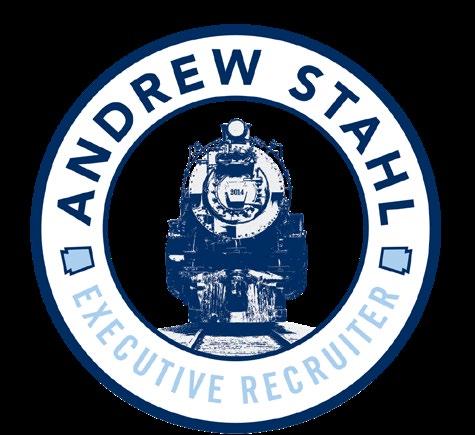






Last year was an exceptionally dynamic year for our sales efforts, marked by impressive momentum and significant achievements that underscore the dedication, perseverance, and hard work of our teams across the board.
This momentum has set the stage for the new year, with promising contracts already announced in both the United States and India, two markets that are critical to the execution of our growth strategy. These successes are not merely the result of commercial efforts, but also the outcome of the strong collaboration between our teams. Previous year, we have been able to deliver ETCS simulators in Australia, Freight solutions in Mexico, simulators for Maintenance in India, etc.
We had the unique opportunity to participate in a highly productive seminar in India, which played a pivotal role in aligning our strategies across various operational aspects. The seminar fostered deeper collaboration and a shared understanding between our teams from different geographical regions. This event helped ensure that all aspects of our operations are not only aligned but that we are working together with a unified approach to meet the evolving demands of an increasingly dynamic and competitive market. By reinforcing coordination and creating synergies across various regions, we have positioned ourselves much more effectively to seize opportunities and tackle challenges on a global scale.
Looking ahead, this enhanced sense of cohesion and the strategic clarity it provides will be essential for sustaining our growth trajectory, optimizing the

execution of our projects, and capitalizing on the new opportunities that will inevitably arise. With the strong foundations we have in place, we feel confident that we are not only equipped to handle the challenges that lie ahead but also poised to continue delivering outstanding results and advancing our leadership position in the industry.
One of the most notable accomplishments of the past year was the success of our flagship product, Oksygen. This cutting-edge, simulation-based training system was meticulously designed to offer an immersive and highly realistic learning experience for railway operators. Powered by Unigine, Oksygen ensures precise track modeling and dynamic training conditions, with highly detailed and accurate geographical environments that reflect real-world scenarios. This makes it an invaluable tool for training operators, helping them to develop and refine their skills in a safe and controlled environment.
Oksygen's impact was further reinforced by the overwhelmingly positive feedback it garnered at InnoTrans, the world’s largest and most renowned international trade fair for railway transport technologies. The event served as an excellent platform to highlight Oksygen’s capabilities and potential with our new Lite configuration, and the significant interest it sparked has opened the door to numerous promising opportunities. Additionally, we were proud to collaborate with Siemens to showcase an innovative approach by linking their Digital Twin to our platform. Customers were asking if track view was reality or 3D!?
By merging these advanced technologies, the partnership aims to enhance fidelity in operator training. This ensures trainees experience the highest level of accuracy and realism, essential for optimal performance. Additionally, the digital twin model will continuously be updated with the latest software
versions, guaranteeing operators always train with the most up-to-data and system parameters.
One of the key advantages of Oksygen is its userfriendly design, which allows instructors to easily create and manage a wide variety of training scenarios. The system offers flexibility to adjust key parameters, such as train behavior, traffic patterns, weather conditions, and emergency situations, in real-time. This versatility makes it an ideal tool for creating realistic and diverse training scenarios, ensuring that operators are wellprepared for a wide range of situations. The platform also features real-time monitoring capabilities, interactive controls, and comprehensive performance evaluation tools that allow for thorough skill assessment and continuous improvement.
Thanks to its advanced world-building tools and comprehensive simulation features, Oksygen enhances the efficiency of training programs, boosts the readiness of railway operators, and contributes to overall improvements in railway safety and operational efficiency. The feedback we have received from customers and industry experts alike has been overwhelmingly positive, confirming that Oksygen is a truly transformative product for the railway industry.



In light of the success Oksygen has garnered thus far, we are excited to explore new collaborations and deepen our market presence. We firmly believe that the continued development of Oksygen, along with its expanding adoption in key markets, will be instrumental in furthering our growth and ensuring that we remain at the forefront of innovation in the transportation and simulation sectors.
As we move forward, we are more determined than ever to leverage our strong foundations, cohesive teamwork, and strategic vision to continue delivering exceptional results and pushing the boundaries of what is possible. With Oksygen leading the way, we are confident that we will continue to make

significant strides in both product development and market expansion, ensuring long-term success and sustainability.
We are excited to announce that we will be participating in the Asia Pacific Rail conference at the end of May in Bangkok. This event provides a fantastic opportunity to showcase our latest innovations in the railway sector. During the conference, we will present highly engaging and cutting-edge demonstrations, in collaboration with our technology partners, Varjo and Unigine. These demonstrations will highlight the latest advancements in simulation-based training and mixed reality, offering attendees a firsthand look at the future of simulation for training. Our participation as a Silver Sponsor underscores our commitment to advancing the railway industry through conferences and panels. We look forward to connecting with industry leaders and exploring new opportunities in this rapidly evolving region. If you are a rail operator and plan to attend this event, we can facilitate a visit to the SRT Simulation Training Centre before (a full configuration with Desks, Observers’ station, Full cab on motion with Instructors’ stations). Get in touch with us
www.sogeclair.com


Thank you for reading Issue One 2025 of the Railway-News magazine. Visit our website to keep up to date with the rail sector.